6.2: Installation Art
- Last updated
- Save as PDF
- Page ID
- 174446
Introduction
Installation art is a relatively new genre for the millennium defined as large-scale constructions, usually mixed media, and installed for a specified period. The artwork usually fills the space, and viewers must walk through the exhibit, often becoming part of the installation. However, some installations might be fragile or installed along a wall. A sculpture is generally one piece of art displayed in separate or individual spaces. An installation is a more unified experience, engaging the viewer in most of the environment. Technology has also contributed to the ability of artists to create large installations involving LEDs, computerized movement, unusual formations, and even environmentally supported projects. One attribute of installation art is its immersive properties, how the art appears depending on the viewer's position. The works are also large in scale and site-specific, made to fit into the gallery and museum. or outdoor space. Generally, they are placed in unique surroundings to compliment the artwork.
Ai Weiwei
Ai Weiwei (1957-) was born in China, his father a poet. The family was sentenced to a labor camp when Ai was one, then sixteen years in exile in far northern China. After Mao Zedong's death, the Cultural Revolution ended, and the family moved back to Beijing, where Ai studied animation. He moved to the United States for twelve years to learn English and art. He returned to China when his father's health failed in 1993 and set up his studio. Ai began to openly criticize the Chinese government's human rights issues, corruption, and lack of democracy. Most of his work follows his political beliefs and feelings about the social problems in China, leading to harassment by the government and occasional house arrest. In 2011, Ai was jailed for three months; however, the government kept his passport when he was released, and he could not travel. When his passport was returned in 2015, he moved to Europe. Ai Weiwei uses his art as dissident art, protesting human abuses in China by the government. His work is international and brings his messages to the world. He uses simple or everyday objects or materials to create his installation as he believed they were meaningful to people.
Sunflower Seeds (8.2.1) is composed of 100 million small seeds stacked evenly on the floor. Each seed appears the same; however, every seed is unique. The life-sized seeds are made by hand from porcelain, sculpted, and painted. The seeds were produced in small workshops in the city of Jingdezhen, known for their production of porcelain since 1004 CE, and originally produced the Imperial porcelain for the royal palaces. Revolutionary types of kilns and access to deposits of petuntse, the clay needed for porcelain were part of the cities success to become the major Chinese porcelain site, even today. Ai Weiwei used the concept of porcelain sunflower seeds to examine the idea of 'Made in China' and its position in the global economy. He created each seed piled in the installation to represent the relationship between an individual and the masses. He posed the questions: "What does it mean to be an individual in today's society? Are we insignificant or powerless unless we act together? What do our increasing desires, materialism, and number mean for society, the environment, and the future?"[1]
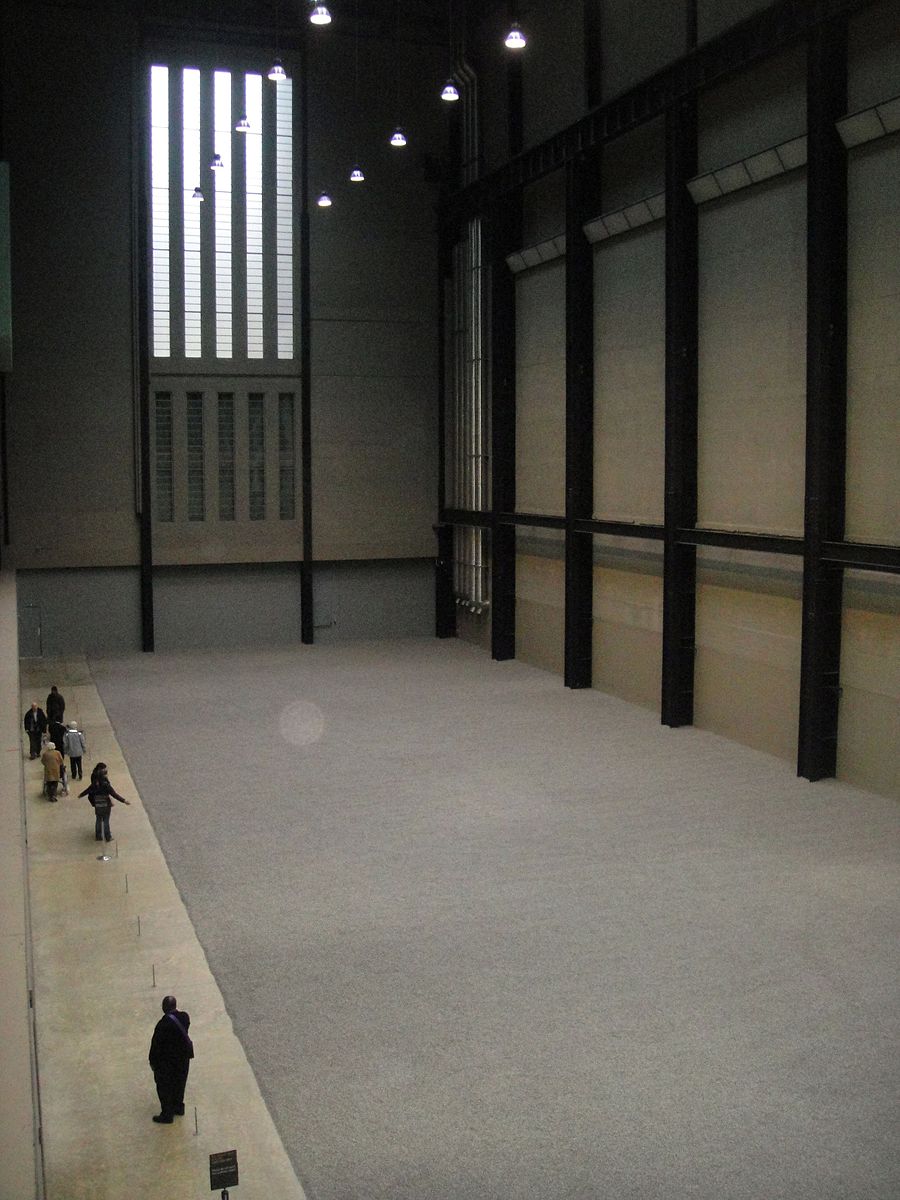
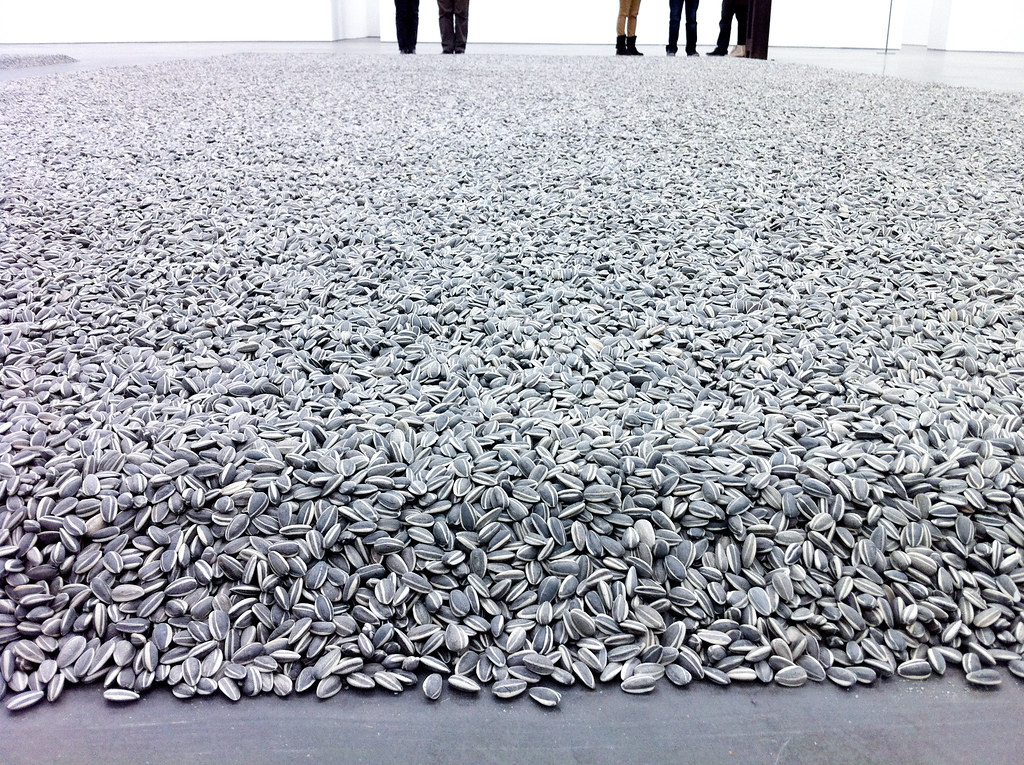
Ai Weiwei's installations reflect his commentary on society, politics, and economics in contemporary China, and he uses irony to create his installation. World Map (8.2.3) is an example of simple, basic objects to make a simple visual expression.
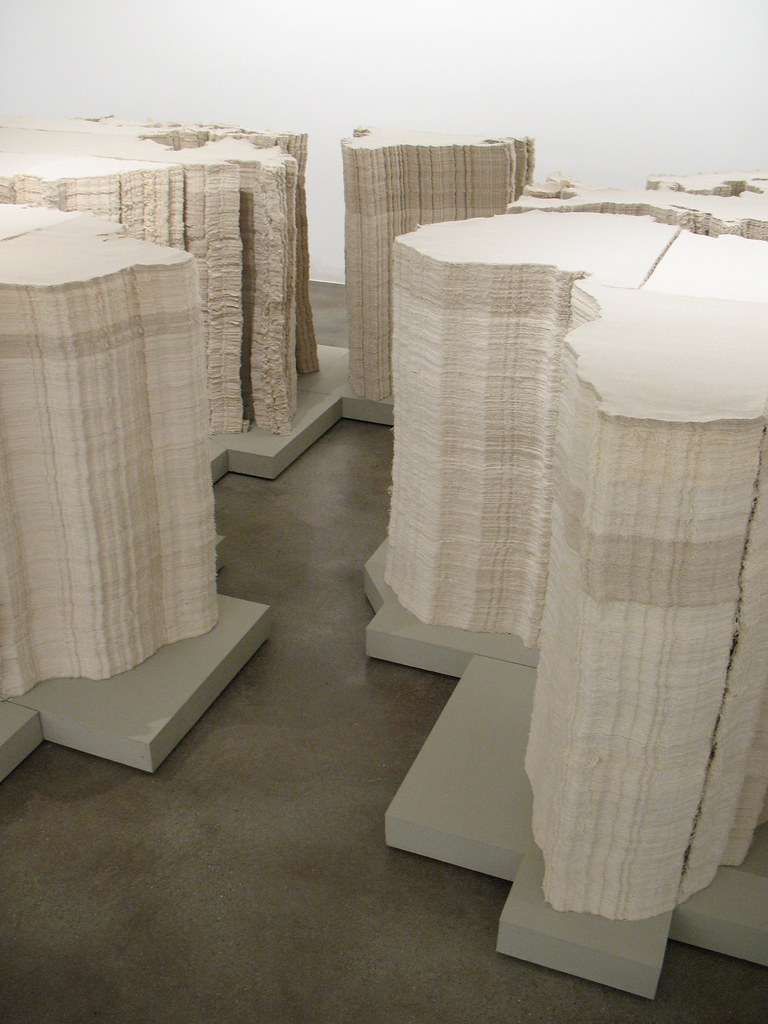
The map comprises thousands of layers of very fine, thin cotton cloth (8.2.4). Making, cutting, stacking, and installing the cloth was exceptionally time-consuming and laborious. The map demonstrates China's position in the world as a place of cheap labor, especially in the clothing industry. Ai stated, "China is blindly producing for the demands of the market… My work very much relates to this blind production of things. I'm part of it, which is a bit of a nonsense."[2] He also uses other materials to make maps of China in protest, including 1,800 milk tins to protest China's tainted milk, making infants sick.

In the installation, Moon Chest (8.2.5), Ai made 81 chests of wood, each with four circles cut in the upper and lower panels on both sides. The openings vary on each chest, and when the chests are carefully aligned, the moon's phases are visible. He wanted to create an installation of simplistic materials and construction while having a sense of functionality. The chests were made from Huali wood, a common material for Chinese furniture, and were constructed without any joining materials, the methods used for ancient furniture. The exhibition was one of the few of Ai's installations without a direct political message, emphasizing artistic beauty.
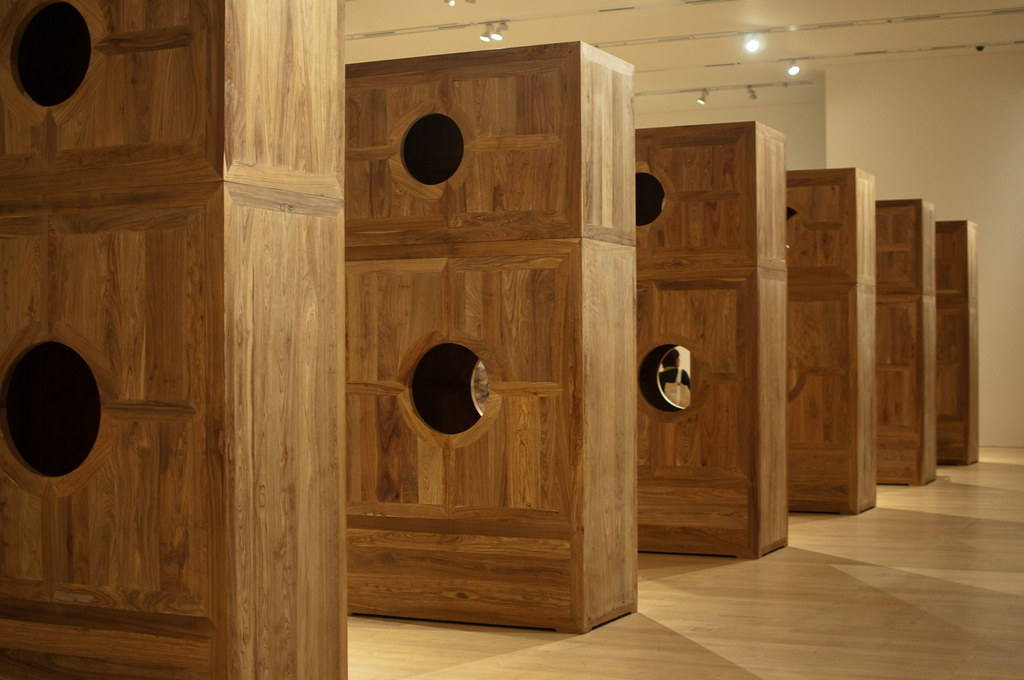
Ai Weiwei created different bicycle installations to acknowledge China's past reliance on bicycles, the mass-produced transportation now becoming obsolete to the car culture. Forever (8.2.6) is one of the installations. Bicycles can be installed in multiple configurations representing the universal use of the bicycles and the beauty found in the object. However, the chain and pedal have been removed from each unit, now obsolete and unusable. However, the bicycles are arranged in a circle giving the feeling of motion—the "forever" of the title belying the actuality.
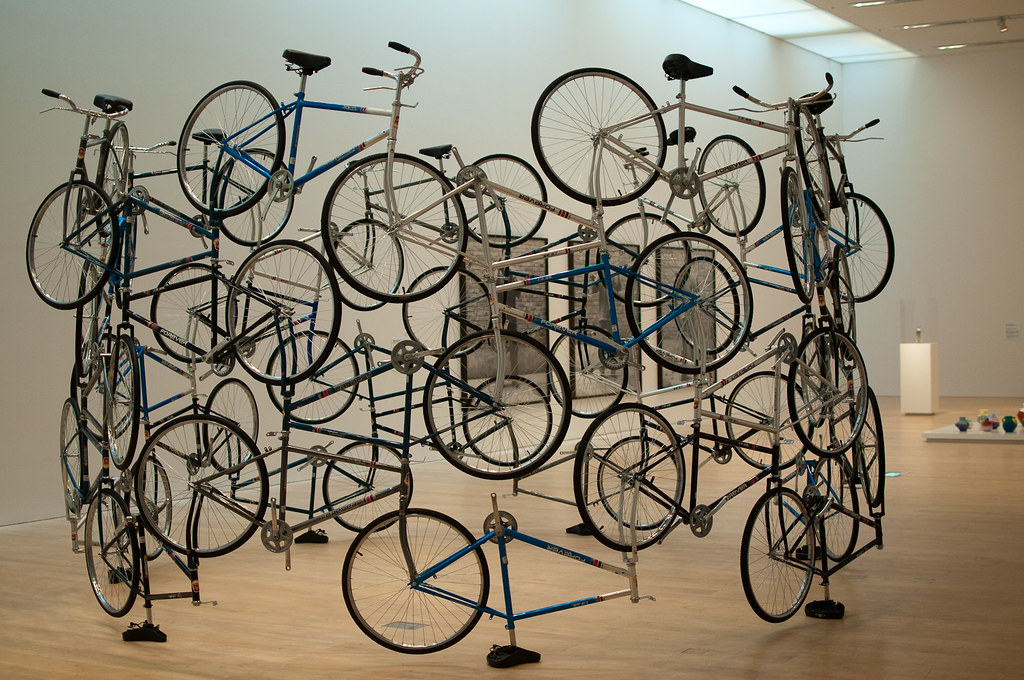
Ai Wei Wei's accumulations and use of single objects are used again in installations with stools. Both installations (8.2.7, 8.2.8) demonstrate how he combined small and large sets of stools. The three-legged wooden stool was typical in China, now an antiquated object in today's Chinese society. Previously, the stools were carefully carved and passed down through the generations, an expression of centuries-old aesthetics. Today stools are plastic or aluminum in China, a modern and mass-produced object, disposable in today's society. A common symbol of the importance of and creativity of the individual as opposed to the massive state.
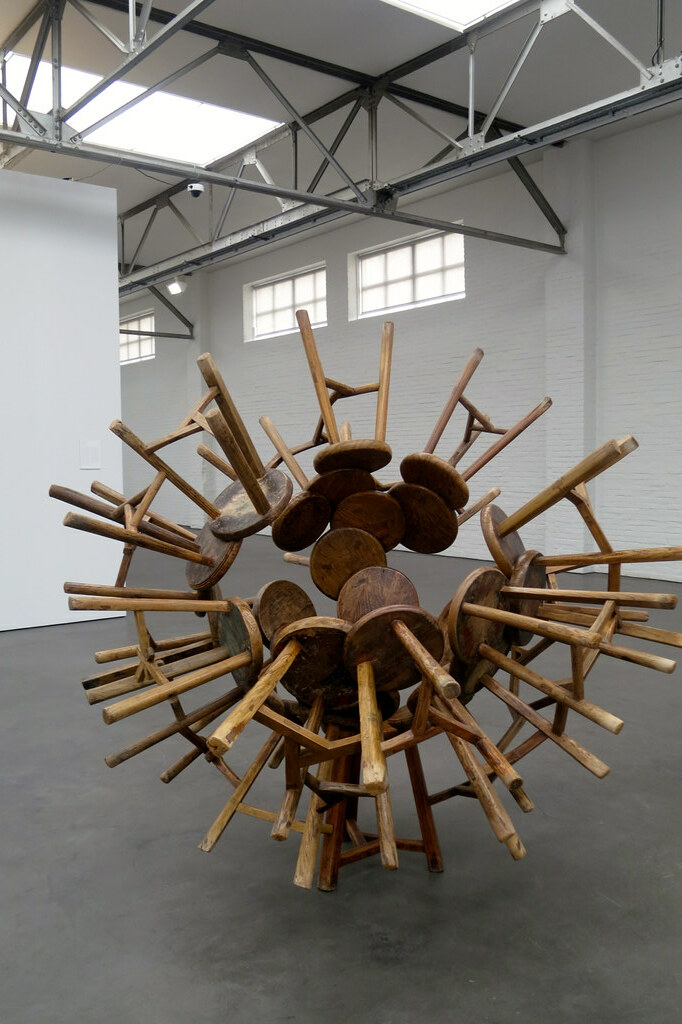
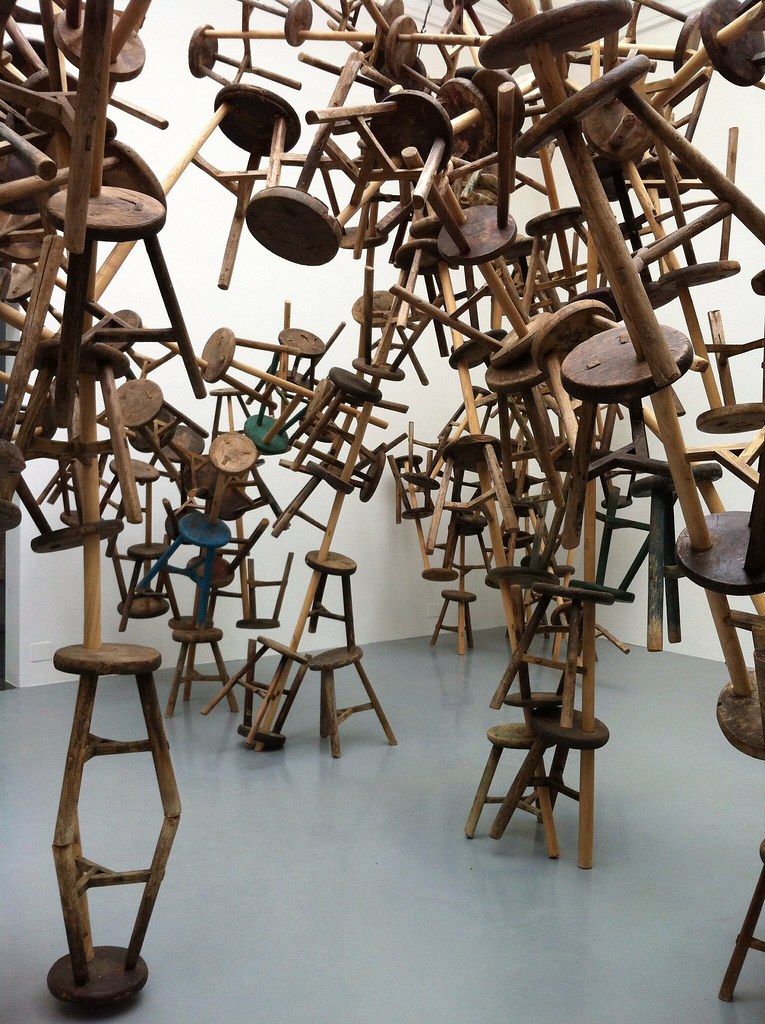
Yayoi Kusama
Yayoi Kusama (1929-) was born in Japan, where her parents owned a nursery for plants and seeds. Kusama started drawing pumpkins from the time she was a child. She said she drew from hallucinations she observed, a concept followed throughout her life. Kusama's childhood was traumatic; her mother did not support her art and was abusive. Her father had continual extramarital affairs, which her mother made Kusama follow him and spy, reporting back. By the time Kusama was ten, her hallucinations had included flashing lights and fields of dots she believed engulfed her. She studied traditional Japanese Nihonga style, finding it unsatisfactory, and studied Western avant-garde. After success in Japan, at twenty-seven, she went to the United States from 1957 to 1972, believing Japan was too disparaging of women and too feudalistic.
In the United States, Kusama developed her reflective mirror rooms, complex installations with mirrors, colored balls, and lights. She worked successfully with other artists in New York City, however financial success eluded her. During this period, Kusama became heavily involved with the anti-Viet Nam war protesters, often doing unusual things to draw attention to her demonstrations, including painting polka dots on nude protesters. When Kusama returned to Japan in 1973, mentally ill and suicidal, she checked herself into a hospital. Since that period, she has resided in the psychiatric hospital, creating her art in a nearby studio.
Dots have become Kusama's obsession on all her artwork and installations, dots covering everything in repetitive patterns. Kusama said, "A polka-dot has the form of the sun which is a symbol of the energy of the whole world and our living life, and the form of the moon which is calm. Round soft, colourful, senseless and unknowing. Polka-dots can't stay alone; like the communicative life of people, two or three and more polka-dots become movement. ...Polka-dots are a way to infinity."[3] Most of her work is based on the repetitive use of dots, beloved pumpkins, and mirrors in her installations. Dots Obsession (8.2.9) is like Kusama's hallucinations in childhood, believing her space was covered in patterns. In this installation, she used red for the base color and the highly contrasting white dots. The room was enclosed with mirrors, multiple lights, and large balloon-like structures, giving the viewers an immersive involvement.
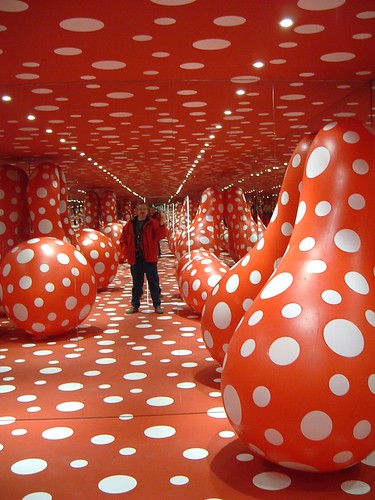
Repetitive Vision (8.2.10) creates a startling strange, and disorienting environment. The black mirrored walls and ceiling reflect the mannequins covered in red dots. The mirrors present views of the front, back, and sides of the mannequins confusing the viewer, impossible to know the limits of the room or numbers of mannequins. The red dots on the floor, mannequins, and reflections add to the confusion of the room's boundaries. Kusama said, "A mirror is a device which obliterates everything, including myself and others in the light of another world or a gallant apparatus which creates nothingness."[4]
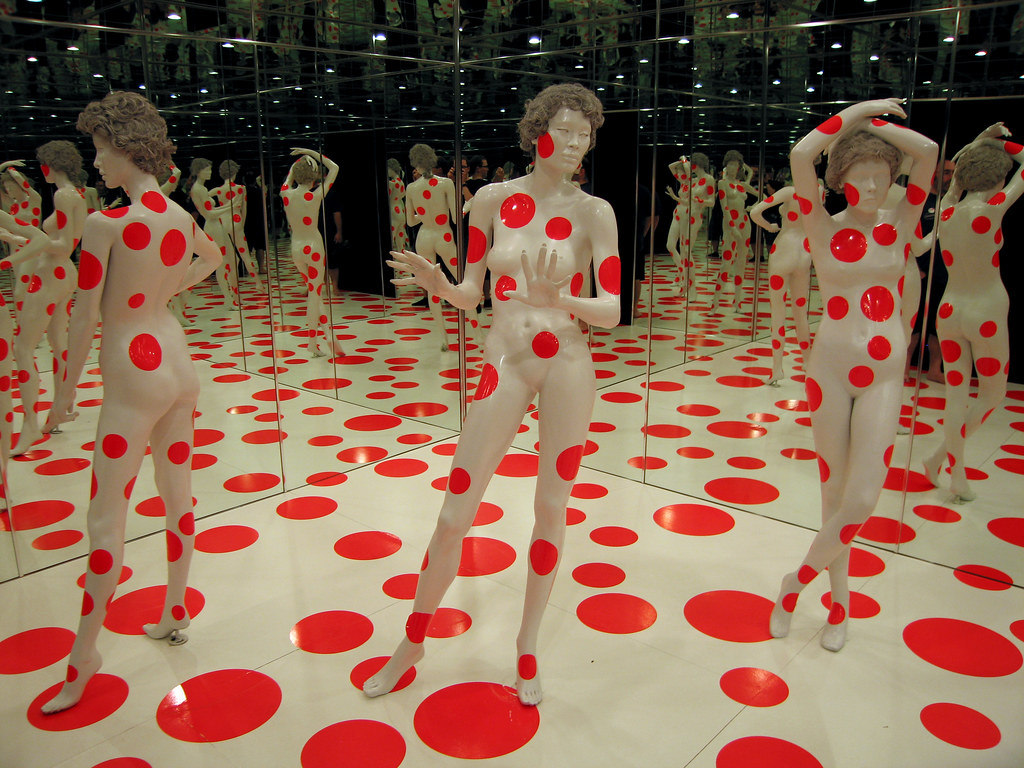
Late in her career, Kusama's infinity rooms expanded and included her trademark dots and pumpkins. The mirrored and lighted ceiling and walls infinitely reflect the dotted pumpkins in All the Eternal Love I Have for the Pumpkins (8.2.11). The illusion of the installation stretched the concept of ad infinitum. Kusama has placed rows of yellow pumpkins painted with strips of black dots, making the room's depth impossible to judge. The space reflects Kusama's obsessive-compulsive disorder for the repetition of polka dots enclosing the person in the room, the pattern wrapping around and surrounding the viewer.
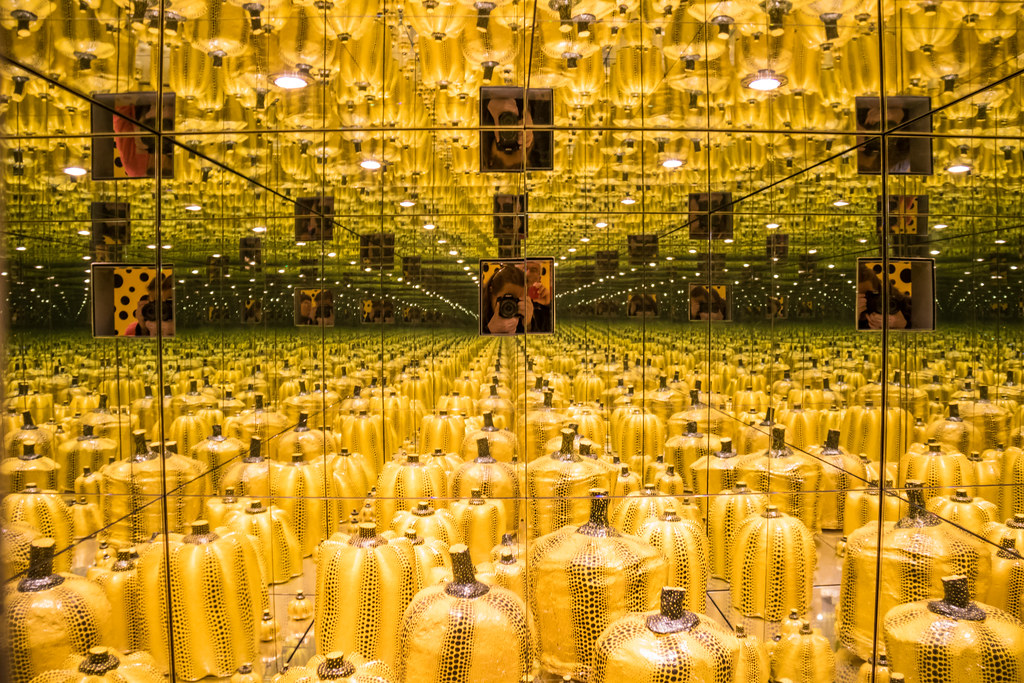
In Japan, pumpkins are known as kabocha; an image Kusama spent hours drawing as a child. Pumpkins represented stability and comfort and were attractive in color and shape. By the late 1970s, she started to include pumpkins in some of her work, covering them with dots and incorporating them into the themes of her mirrored rooms. Pumpkins became major subjects by the new millennium, and Kusama made enormous sculptures. The Red Pumpkin (8.2.12) and the Orange Pumpkin (8.2.13) were made from fiberglass for installation on Naoshima Island in Japan. The oversized red pumpkin sits on the edge of a protected inlet. The sculpture is hollow inside, made from fiberglass, and covered with large black dots. The orange pumpkin with a different set of black vertical dots was installed on the end of a pier adjacent to the water. The pumpkin was dislodged when a typhoon swept the island in 2021, and waves took it into the sea. The sculpture cracked but was recovered and will be repaired.
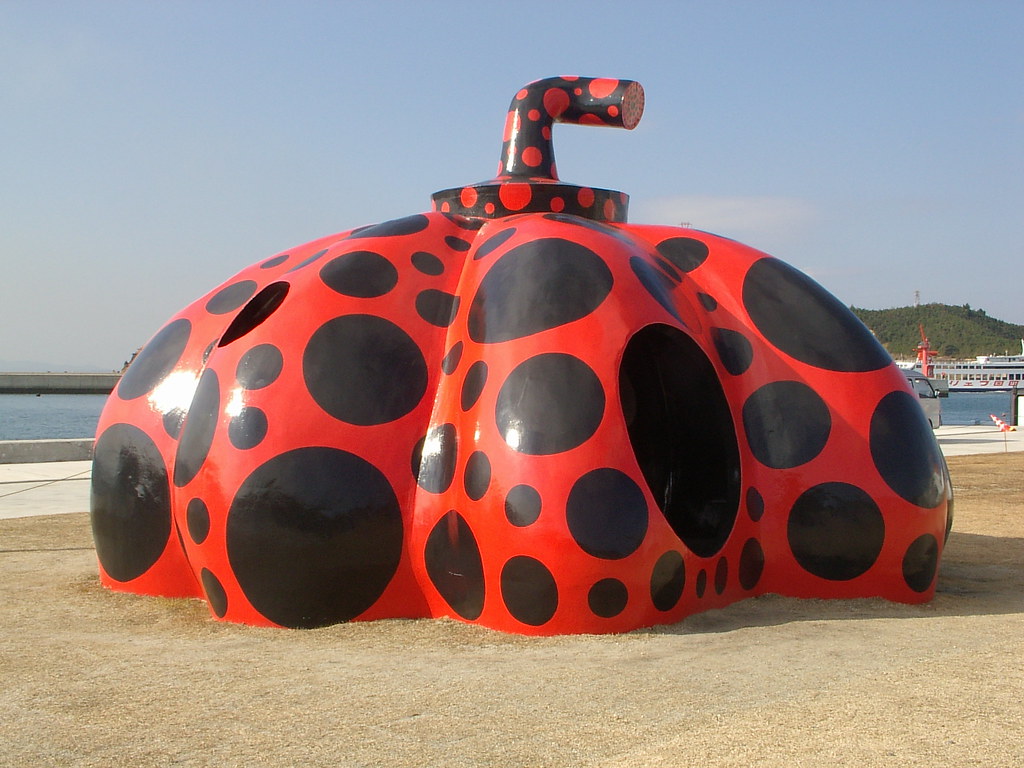
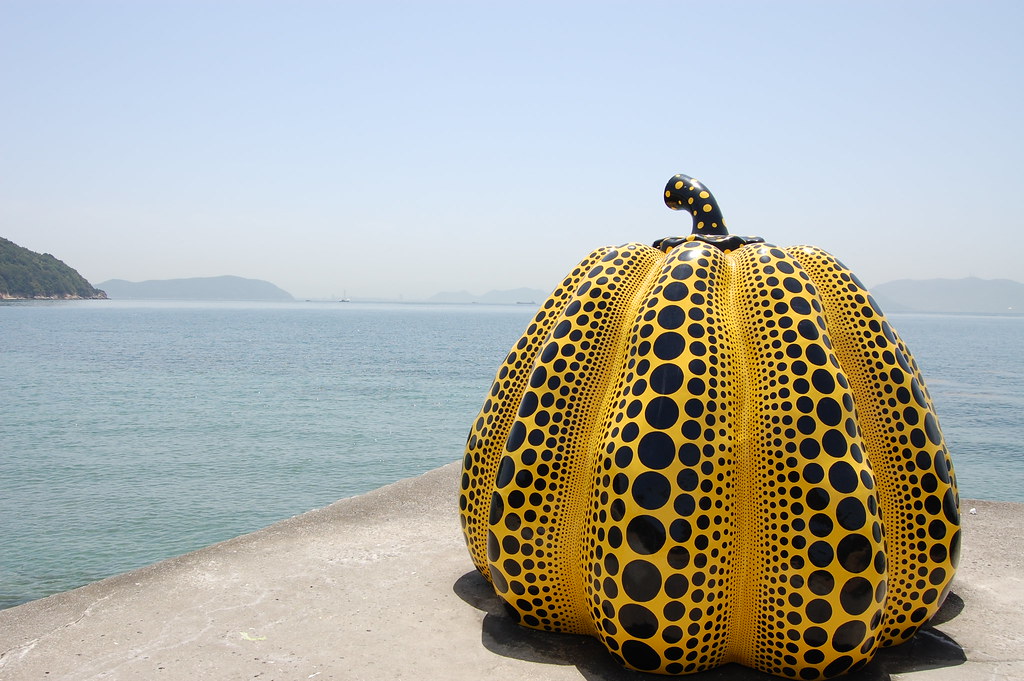
Kusama also made immense pumpkins from stainless steel (8.2.14, 8.2.15). The metal is shiny and reflects light and images like her mirror rooms. The dots on the pumpkins were made with long-lasting urethane paint.
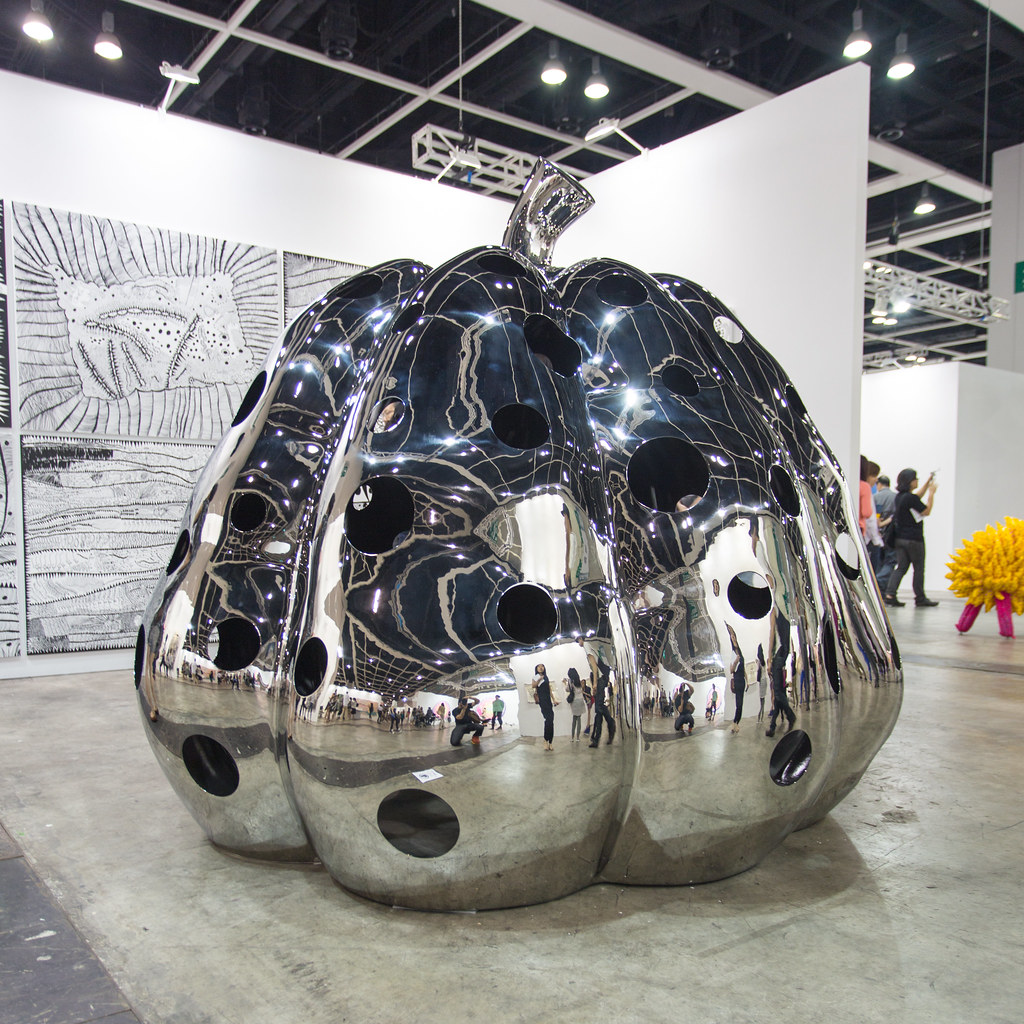
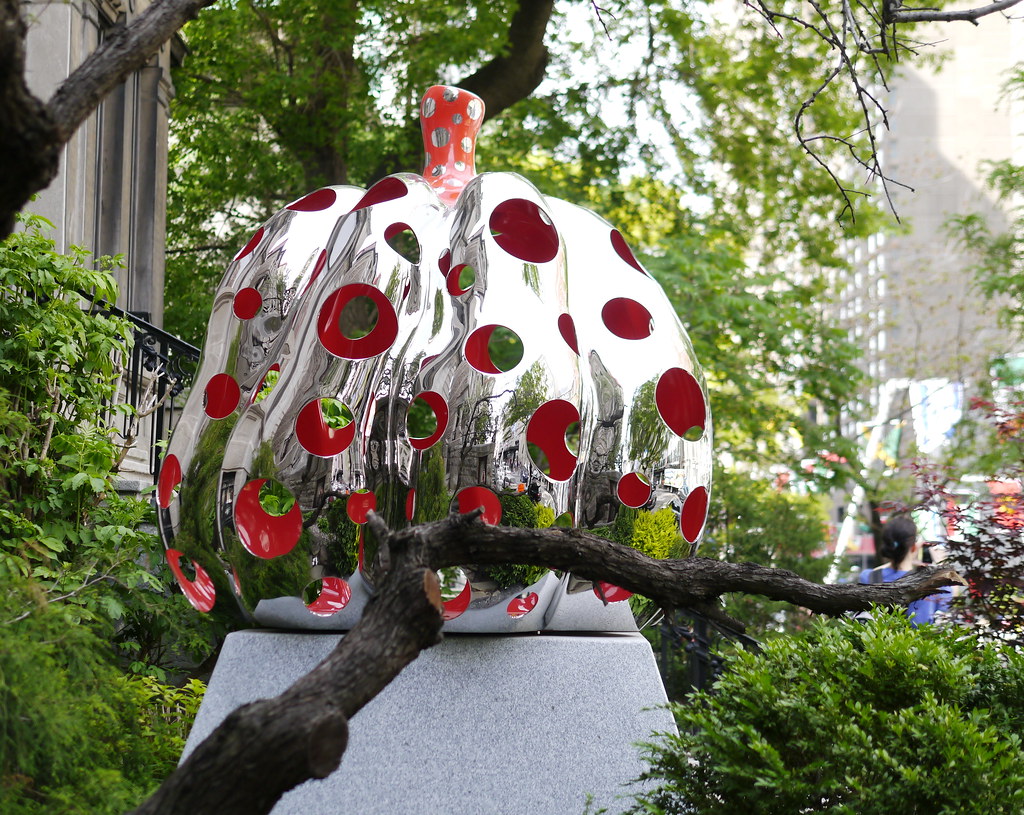
Do Ho Suh
Do Ho Suh (1962-) was born in Korea, the son of a famous artist who used traditional paintings in ink to create more abstract concepts. Originally, Suh wanted to be a marine biologist, failing to achieve the grades. He went to art school in Korea and earned a master's degree in art based on traditional Korean painting. Suh relocated to the United States in 1991, freeing himself from his father's influence and traditional art and studying at the Rhode Island School of Design. Here, he was interested in how space was used and how people interacted in different cultures. Suh explicitly studied houses' psychological and physical dimensions and the architectural structures.
Suh's major project was Home Within Home (8.2.16), a life-sized reconstruction of an actual home where he once lived. Suh also constructed a replica of his home in Korea, contrasting style and size inside the house. He used translucent fabrics to construct the houses, interior rooms, and different large appliances. He also displays hallways, doors, or specific rooms from various places he lived in other installation parts. Suh used a 2-D scanning machine to ensure accurate and exact specifications. Using the defined dimensions and outlines, Suh used a traditional Korean hand sewing method to make every part of the building or objects, adding precise details found in the actual item. The oversized home is designed for the viewer to approach the building and see through the walls before entering the door and walking through the spaces. The rooms in the building create a dreamlike environment; shelves, doors, fixtures, windows, stairs, or appliances are viewable while still looking through to other spaces.
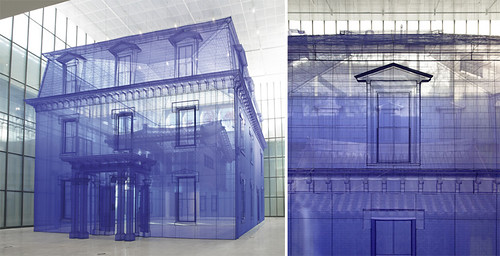
The bathtub (8.2.17) and the toilet (8.2.18) are created in exact sizes and placed in the bathroom. Suh used steel wire to frame the bathtub and toilet to hold the fabric properly. For the larger structures, he used stainless steel armature.
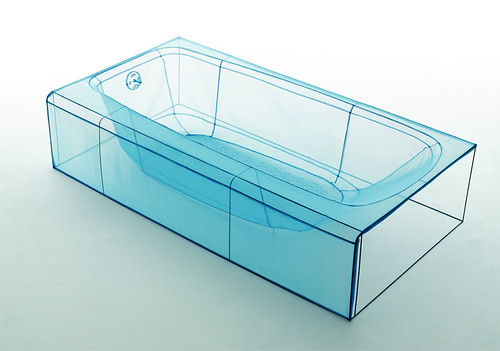
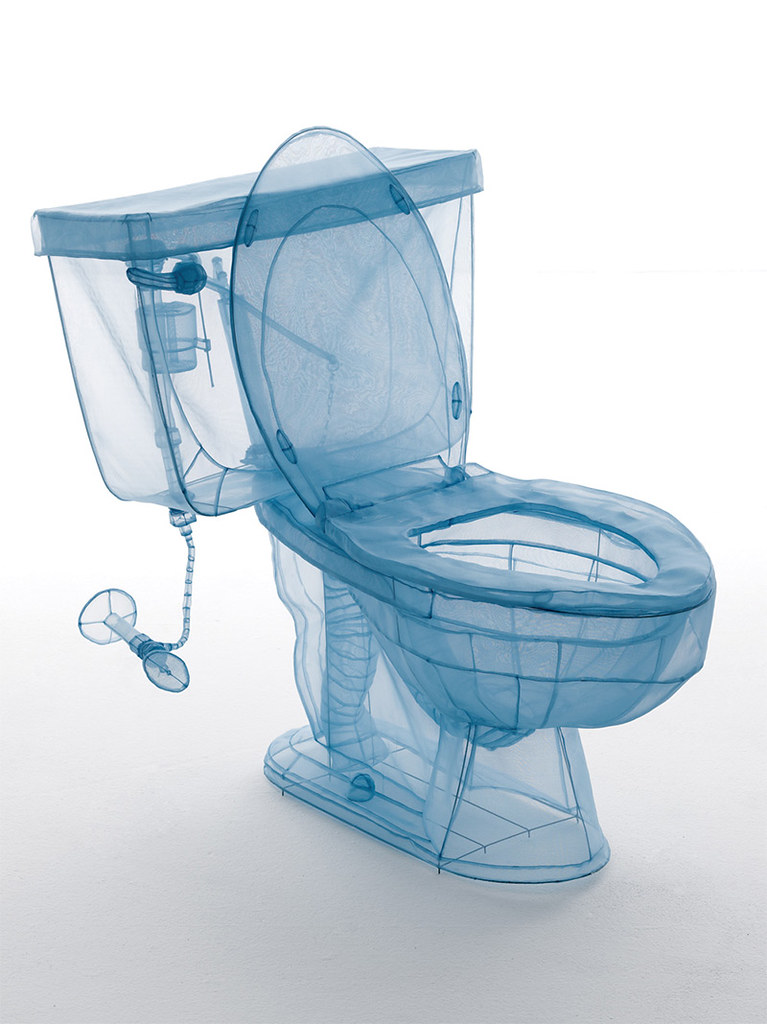
Suh was raised in South Korea, the influence of North Korea and the ever-present threat in the lives of those on the Korean peninsula. The two countries were a display of conflicting social and political societies. The images of North Korean soldiers in precise and continued marching manifested in the concept of the control and collectivism of the state over the thoughts and activities of the individual.
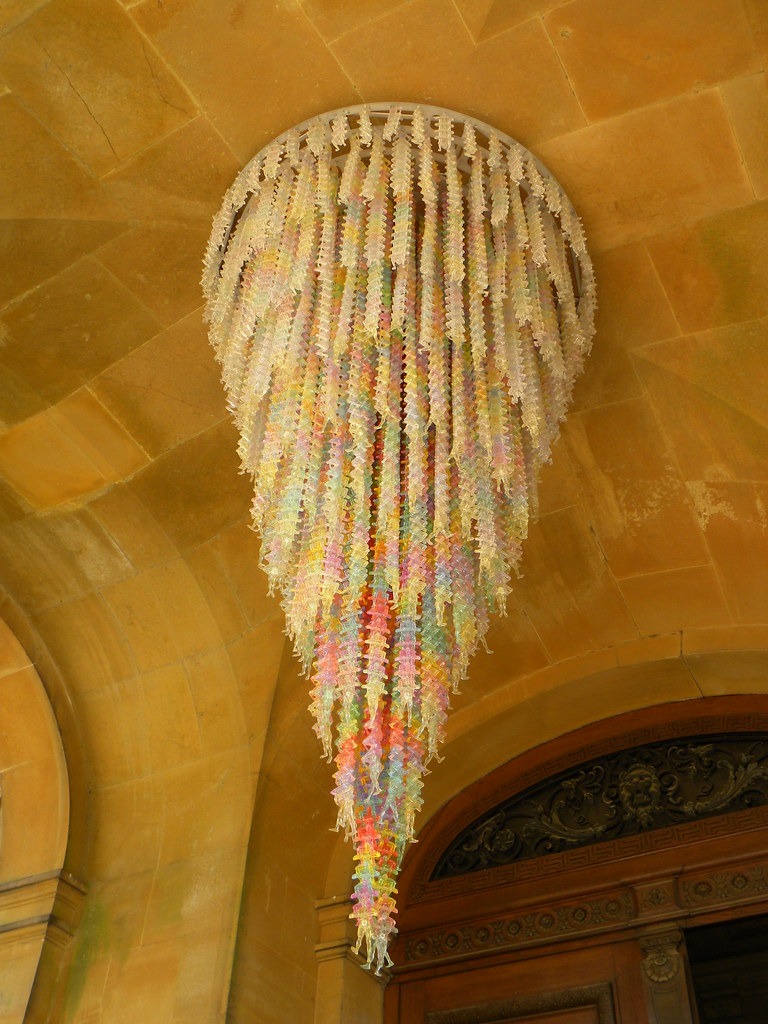
The sculpture Cause and Effect (8.2.19) is made of 1,200 naked resin figures cast in different colors. Each small figure sits on the figure below it, portraying the relationship between the individual inside the collective or the concept of the individual supporting the larger society.
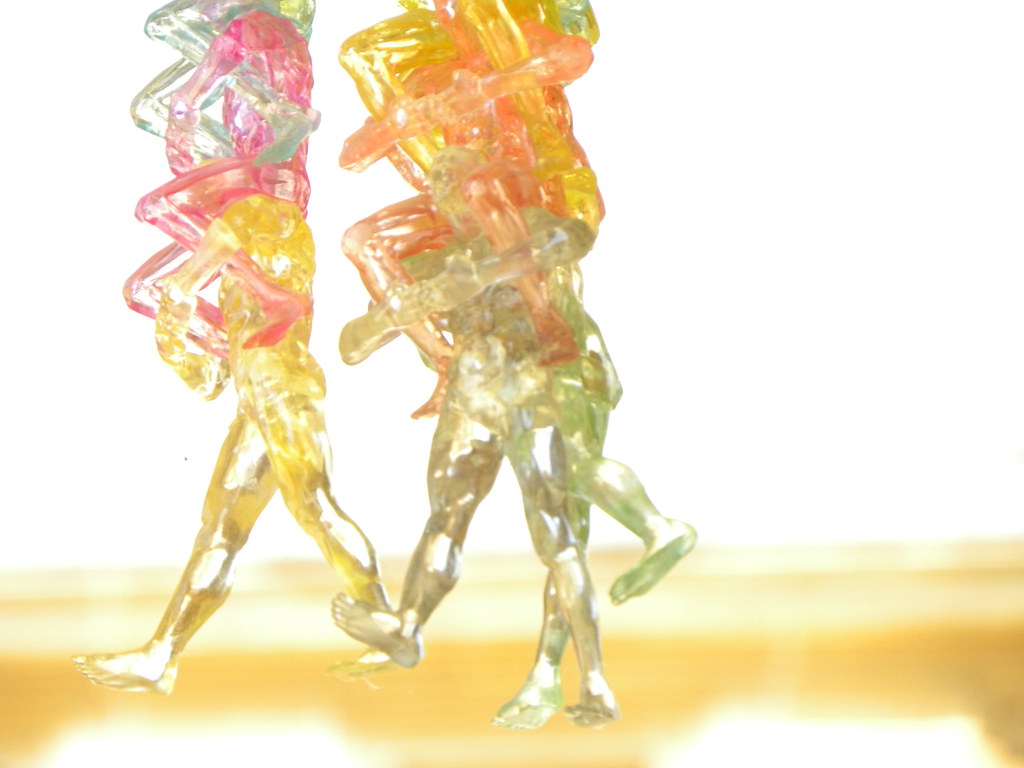
El Anatsui
El Anatsui (1944 -) was born in Ghana, where his uncle raised him. As a child, he drew on a chalkboard and later trained at the University of Science and Technology in Ghana. His early work was based on traditional wood carving and sculpture and teaching at the University of Nigeria. His first entry into the international art world was in Harlem, New York, in 1990 when he entered a show about contemporary African artists. Anatsui found his art medium in the streets of the local towns, discarded liquor bottle caps. After collecting thousands of metal seals from the bottles and bottle caps, he must smooth and flatten them to be more malleable and workable. For his sculptures, he uses copper wire to attach the pieces. His work combines the concepts of traditional African imagery and the ideas of abstraction. Anatsui's work is moveable and easy to configure in different ways. His work does not have a fixed form, and when he sends a sculpture to an institution, he does not send any instructions, allowing them to decide how to hang and drape his work. Anatsui said, "I am interested in textile because it is always in motion. Anytime you touch something, there is bound to be a change. The idea of a sheet that you can shape or reshape. It can be on the floor; it can be up on the ceiling; it can be up on the wall, all that fluidity is behind the concept."[5]
Anatsui noticed walls worldwide and how they close space and stop the eye from traveling further. He wanted to create a wall the viewer can see, though fluid and moveable. The term Gli meant will, however with a different inflection, the word might mean story or even disrupt. Gli (Wall) (8.2.21) is an oversized installation hung from the ceiling representing a wall. However, it is a transparent wall, most of the metal pieces formed into circles, creating visibility through each small opening. Anatsui connected thousands of bottle caps and collars with thin copper wire. The reflective metal shimmers, giving the appearance of curtains moving in the breeze instead of rigid metal.

AG+BA (8.2.22) is an example of Anatsui's selection and application of color. Each of the bottle tops was branded by different companies who bottled the liquor. Anatsui collected millions of the tops and sorted them by color in his compositions. In part of the sculpture, the red pieces were interspersed with gold and some black; the other portion is formed with gold and small amounts of gold and red. The bottle tops are relatively soft and easy to flatten. Part of this sculpture is hanging and draped, the pieces wired together; the sizeable golden section does not drape and is welded into a massive block. Anatsui started using bottle tops when he found three bags of tops. The liquor bottles could be recycled; however, no one recycled aluminum.
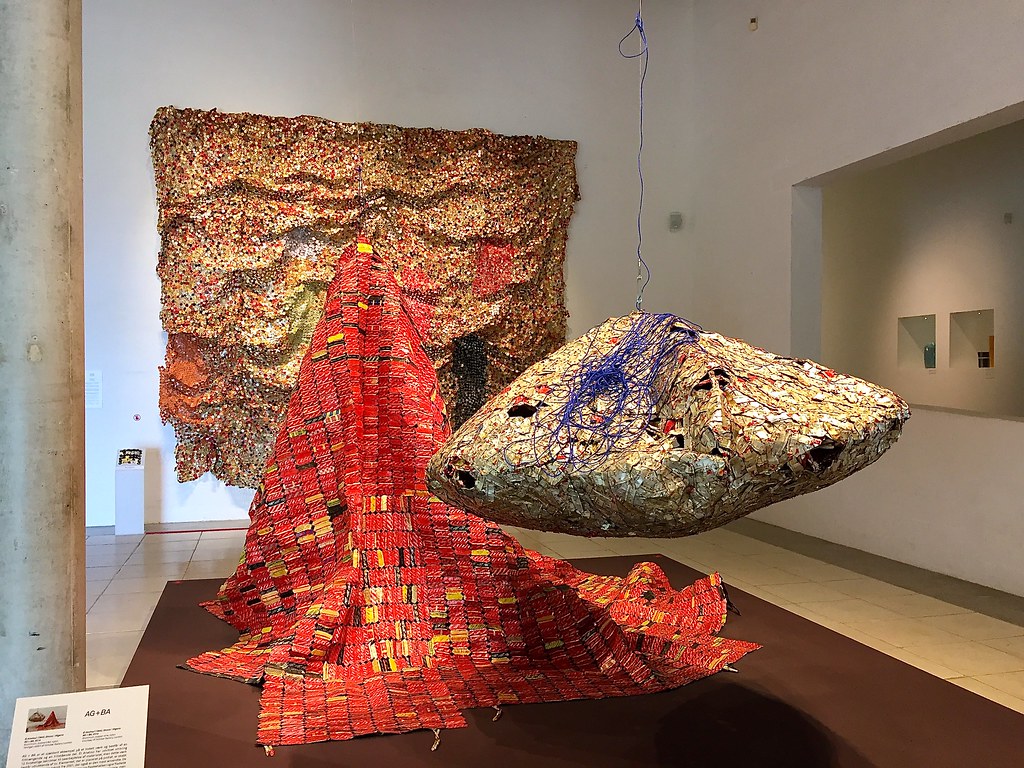
Drifting Continents (8.2.23) depicts a fragmented map of the world where the continents collapse into each other. The work displays the interconnectivity of the regions and the creation of restrictive, poorly defined borders. Wealth and gold flowed out of Africa for centuries causing economic disorder today. In the sculpture, the flattened gold tops flow down the walls, beautifully reflective and demonstrating the beauty of gold and why it is coveted. The discarded refuse of the bottle caps recreating the richness of piles of gold only the value is only in the art, not the materials.

Subodh Gupta
Subodh Gupta (1964-) was born in India; his father died when Gupta was young. He was sent to live with an uncle on a remote farm, where children went to school without shoes or roads. He attended the College of Arts & Crafts in Patna, a place without even a library. When he graduated in 1988, Gupta moved to Delhi, starting his career as an artist. He always loved steel and metal, from the dull brass plates the family used for eating to the replacement stainless steel plates. Gupta started using the everyday kitchen utensils used at home, a material he uses. Line of Control (8.2.24) is a sculpture based on the mushroom clouds developed from atomic bombs and represents the dismaying deployment of nuclear war. Nuclear weapons are always an issue between Pakistan and India and the potential of their use in war. The sculpture also represents geopolitical borders, limitations, disputed territories globally, and potential nuclear warfare potential. The work was constructed with twenty-six tons of stainless-steel pans, thalis, bowls, milk pails, tiffin boxes, and various utensils. Each element was welded together to assemble the sculpture.
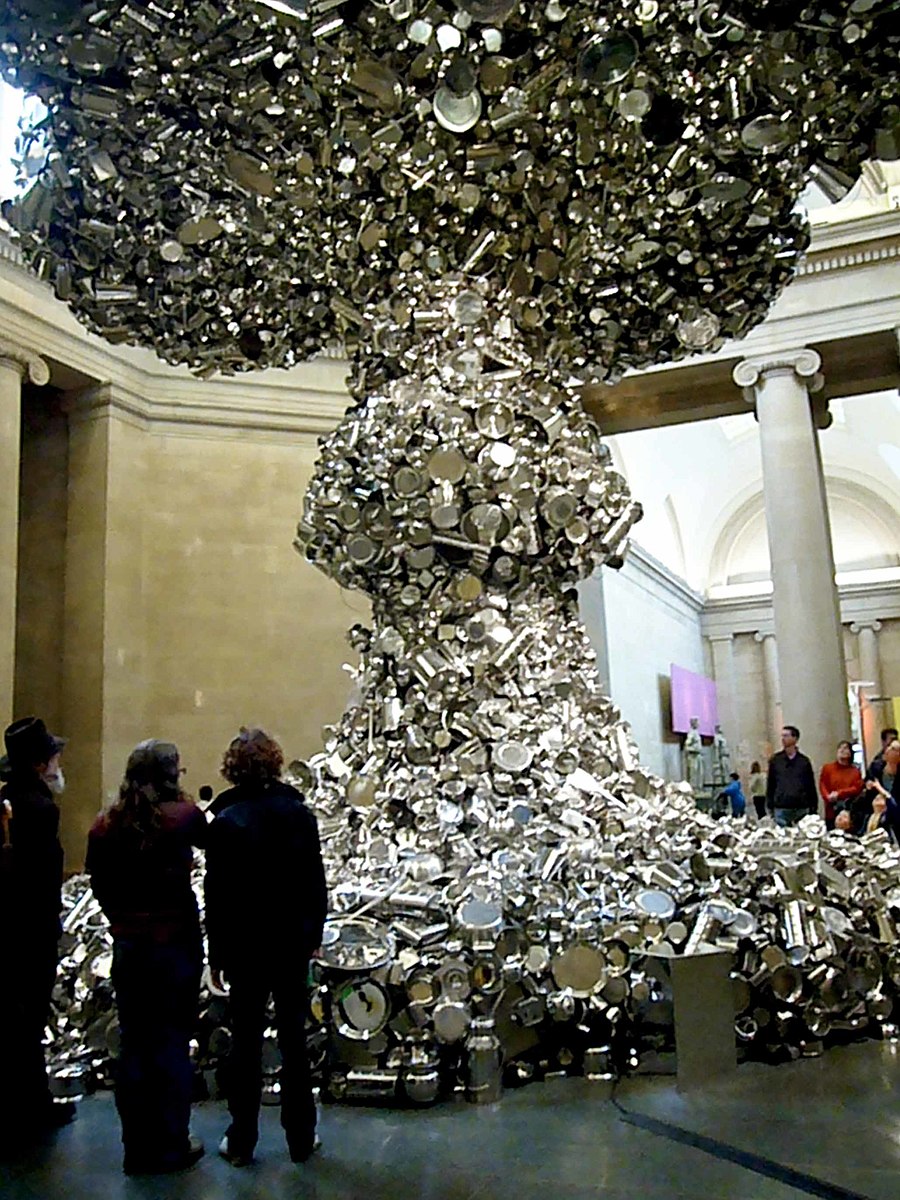
Gupta has always been interested in the migration or displacement in India, even why they travel to other places, carefully noting the changes in Indian society. The Silk Route (8.2.25) comprises stacks of an abundant supply of pots, bowls, and plates carefully arranged on a giant conveyer belt. He presents the growth of the middle class and its constant need for more. The reference to the old silk road defines the influence and threat of globalization changing local communities and the spread of consumerism. The towers of tiffin pots (stackable containers) move along the installation much like India's rapid pace of change. The tiffin pots were a standard method of carrying food when Gupta was a child, the objects now having a different meaning. Gupta said, "My work is about where I came from, but at the same time, the expansion of the art world means that to a certain extent, everything is shrinking together, and you have to be aware of international discourses in your work."[6]
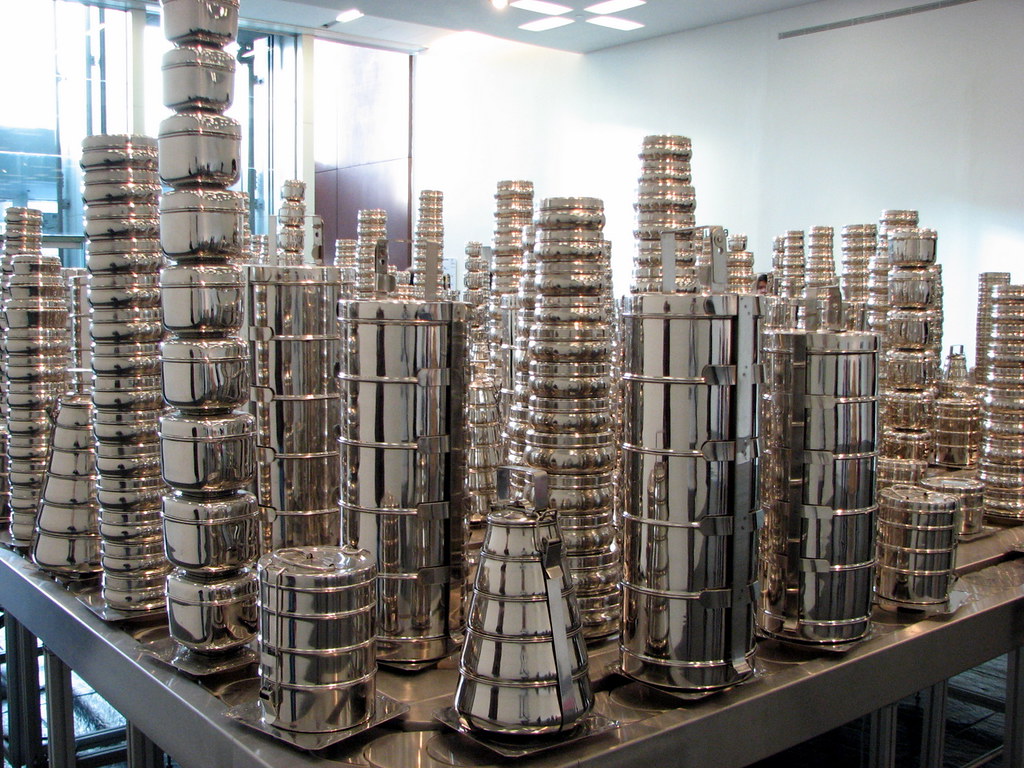
Gupta created the magnificent, stainless-steel banyan tree stating, "I'd like this sculpture to be a place where families gather and get photographed."[7] The structure has become a place for people to sit and pose and ponder the illusion of the sculpture. The tree, Specimen No. 108 (8.2.26), was exceptionally complex to construct. Gupta first made the metal trunk with the branches before the utensils were individually welded to the tree. The tree is shiny with the beauty of an actual tree, elegant and graceful, combined with the ubiquity of common household elements hanging like fruit. The banyan tree is incorporated into Indian culture as sacred and a center of worship; however, the number 108 is meaningful in multiple religions. The imposing tree is a symbol for other meanings. The mystical formation of the tree is further enhanced by the sun bouncing off the steel and the utensils softly moving in the breeze.
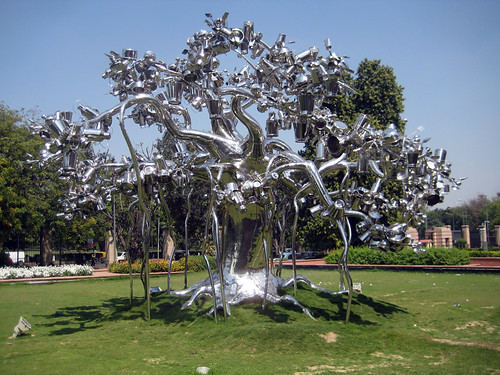
Jean Shin
Jean Shin (1971-) was born in Korea, where her parents were professors. When she was six years old, they moved to the United States. Shin graduated with a BFA from Pratt Institute and an MS in History. Her artwork is made from cast-off materials she collects and forms into installations. She is not particular in her accumulations, including one sock or a broken ceramic, discarded lottery tickets, and even old pill bottles. Shin creates large-scale sculptures and needs large numbers of any one element. She believes the object in an installation may all look the same until closer observation reveals individuality and variety. Shin wants the viewer to continually shift between the group and the individuals within the group, some things more intimate and others appearing excessive.
Huddled Masses (8.2.27) connects the idea of the environmental waste of technology and the desire from society for more and more technological products. The sculpture is made of old cell phones, obsolete by the following year's model. Meters of old, no longer viable computer cables encircle the structure capturing the phones into piles of meaninglessness. The toxic waste now sits, planned obsolescence forcing the new technology to the detriment of the environment from the masses of unusable waste. Large forms jut out of the middle like the ancient rocks of Chinese art, the purity of natural, long-lasting stones of the past, now covered by today's pollution. Oddly, the sounds on the phones made to carry the noise and discourse of society are now silent in their obsolesce. The most significant part of the sculpture is 2.28 meters tall. Shin collected over 3,000 different styles of phones, some as long as twenty years ago, for the sculpture.
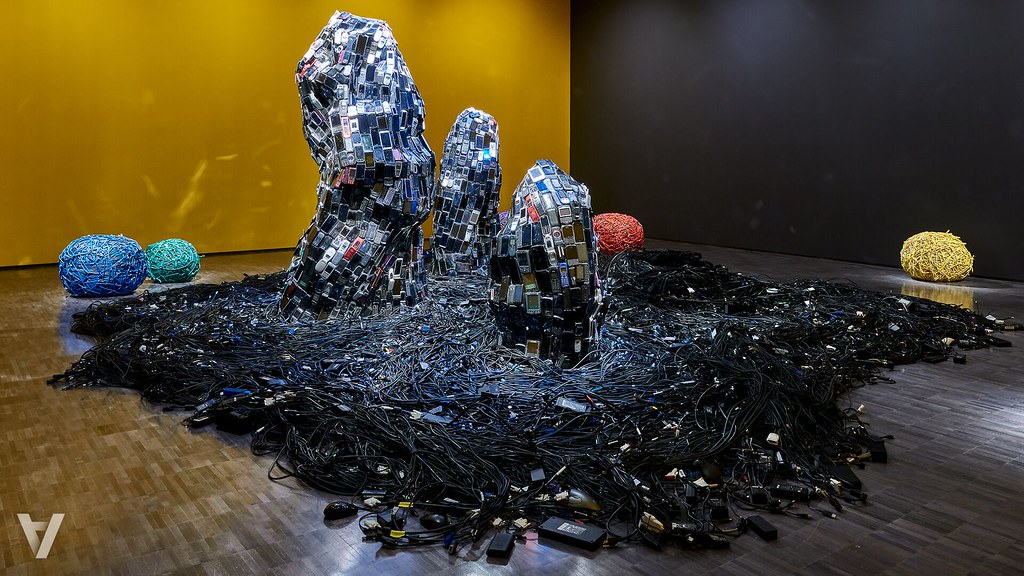
Chance City (8.2.28) was constructed from thousands of losing scratch-and-win lottery tickets, discarded as useless. People purchase them hoping to make money; the losing tickets reveal the unfulfilled dream someone had when they bought the ticket. The worthless tickets are the blocks Shin uses for her colorful houses of cards; it too a temporary structure full of chance and optimism. She does not use any glue when erecting the house of cards, only balancing one on top of another. Although the sculpture looks fragile, gravity and friction hold the cards in place. Shin believes, "Picking up your life and moving to the city and giving I all you can, your dreams may change-transform. But somehow, I think all of us retain that memory of something that they really wanted to do, and against all odds, are able to succeed."[8] The ticket may not bring instant riches, but our odds of success are achievable.
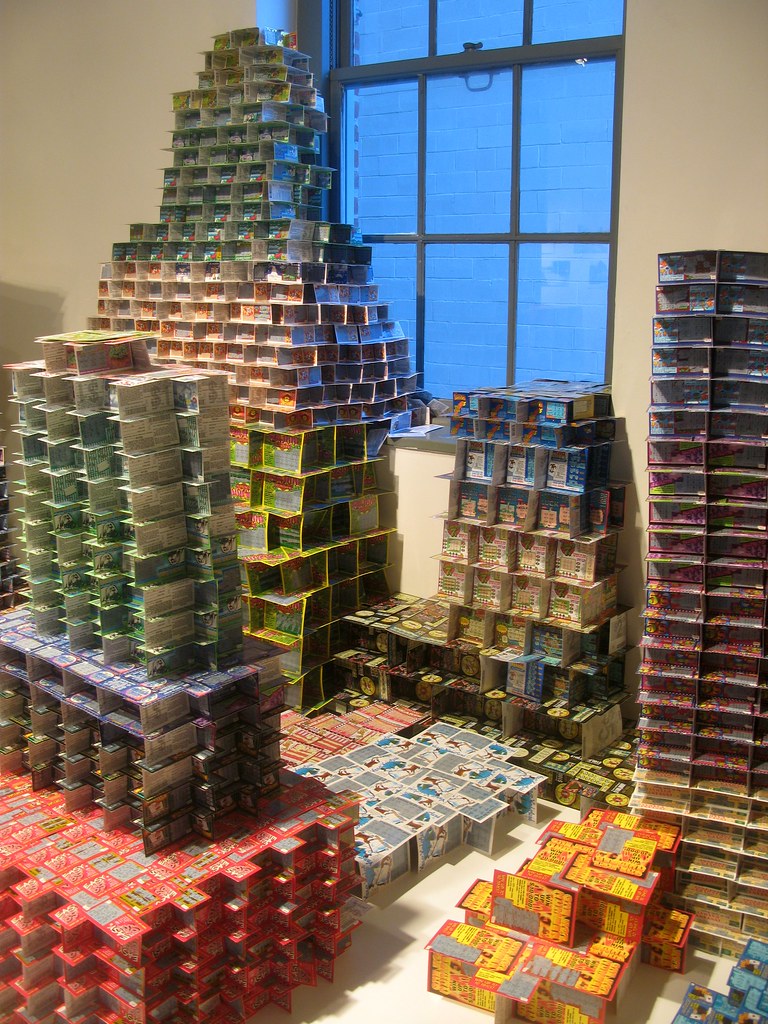
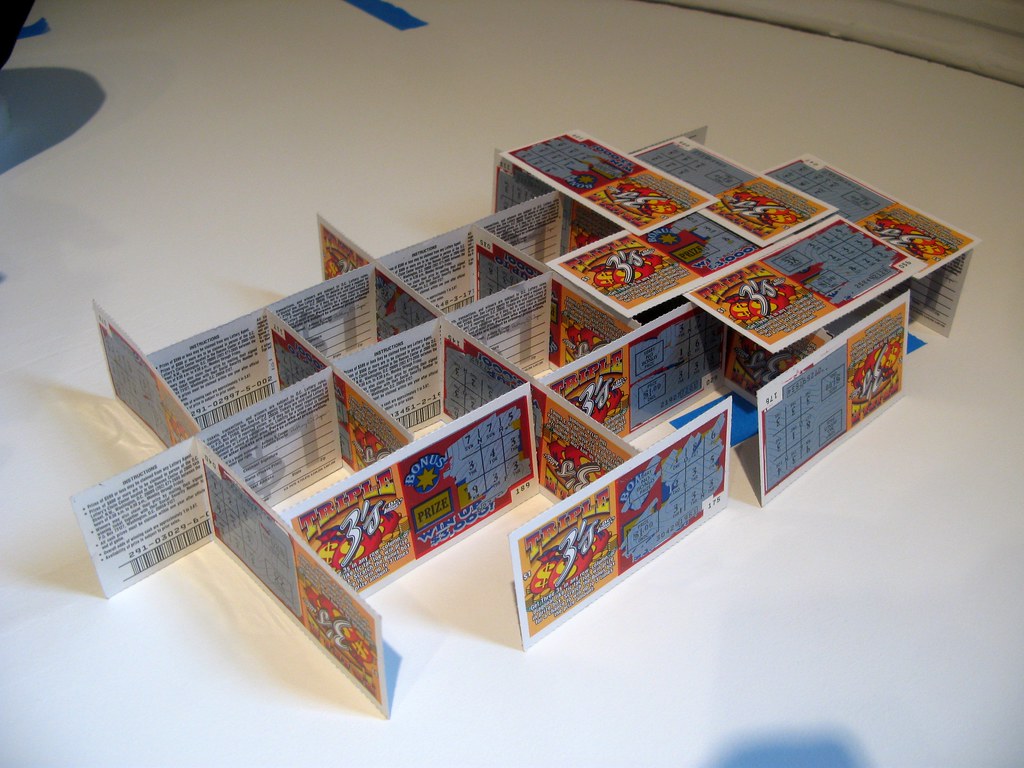
Anselm Kiefer
Anselm Kiefer (1945-) was born in Germany a few months before World War II ended. The city was heavily bombed, a difficult place to live. Kiefer attended the University of Freiburg, first studying languages before switching to art. In the first part of his career, he painted images based on themes from Nazi rule, the Holocaust, or spiritual poetry. Kiefer incorporated straw, clay, ashes, shellac, and lead in the mix of paint applied to the canvas. He used many of his painting concepts and techniques for the large installations. Seven Heavenly Palaces (8.2.30) was based on ideas from an ancient Hebrew writing. The seven towers were fourteen to eighteen meters high, and each weighed ninety tons. Kiefer used reinforced concrete for the towers. He inserted lead wedges between each level. The towers became a summation of Kiefer’s life-long themes of the ancient Hebrews, World War II atrocities, the ruination of Western culture, and the possibilities in the future. He also added large paintings to reinforce his philosophies. Visitors walk through the space to view the towers and paintings, moving between spaces and media. Kiefer added different meanings to each tower. On one tower, he placed an ark representing the ark believed to rest on Ararat. At the base of another tower are small sheets of glass labeled with paper to represent celestial bodies.

Breaking of the Vessels (8.2.31) is a massive installation weighing over seven tons. The bookcase is filled with forty-one lead book folios and interspersed with glass. The books reference Jewish culture and ancient mystical writings. A semicircular pane of glass is suspended above and is inscribed with Hebrew words translating to “Infinite Light .” According to the writings, the attributes of G-d’s light were divided among ten vessels that were not strong enough to contain them and broke, bringing the Divine into an imperfect world.[9] Kiefer frequently referred to the atrocities of the Nazis against the Jews. In front of the bookcase are piles of broken glass, referring to Kristallnacht (The Night of Broken Glass). In November 1938, Nazis and civilians shattered the glass windows in thousands of Jewish-owned businesses and synagogues. The Nazis destroyed and burned all the books they found in Jewish homes, synagogues, schools, or businesses. The books are made from lead, impenetrable, hidden. Kiefer frequently used lead in his paintings and installations, lead representing a crushing, brutal force. He described lead as “the only material heavy enough to carry the weight of human history.”[10]
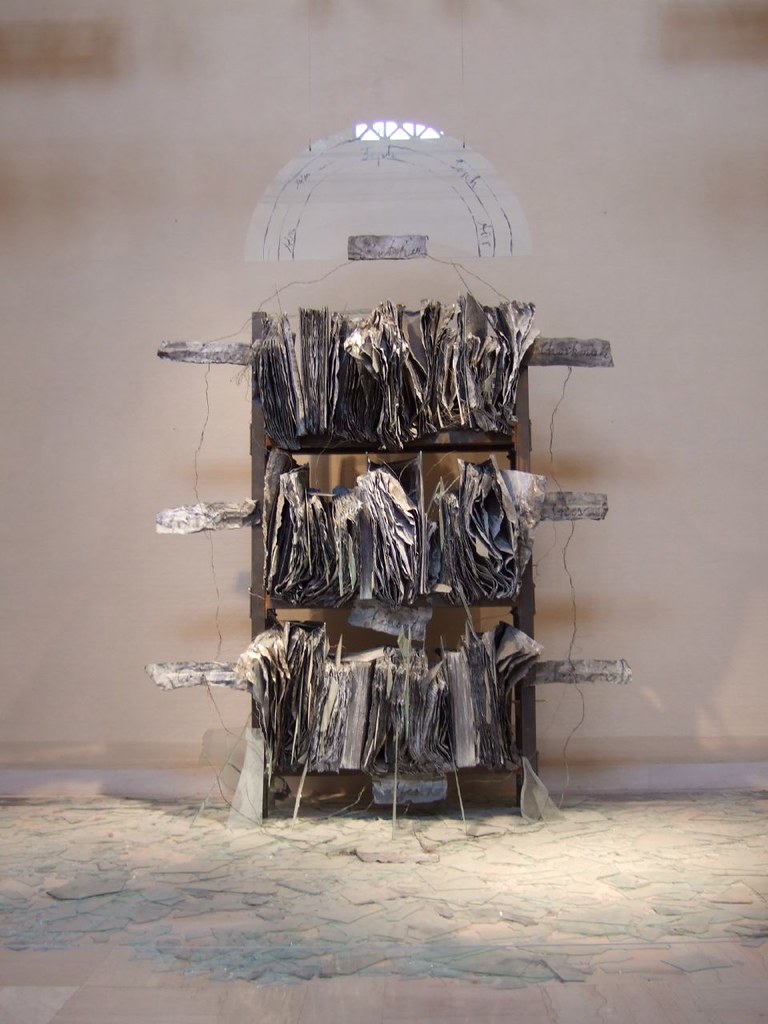
Kara Walker
Kara Walker (1969-) was born in California, her father a painter and professor. Walker said she used to sit on her father's lap and watch him draw, always wanted to become an artist. She received a BFA from Atlanta College of Art and an MFA from Rhode Island School of Design. Walker lived in California until she was thirteen in an integrated neighborhood surrounded by civil rights activists. When she moved to Georgia, Walker was shocked to discover the amount of discrimination, including the Ku Klux Klan rallies, still occurring. The discriminatory practices of the south highly influenced Walker, and her art focused on the brutalities of slavery. Walker is known for her panoramic silhouettes depicting racism, and the realities of life slaves endured. Her work was primarily black figures backed by a white wall using paper, video, shadow puppets, or other projections. Walker has also branched out and created oversized sculptures. Her silhouettes in African't (8.2.32) are almost life-sized. Men, women, and children who were black and white are depicted in different scenes before the civil war. The scenes present a diverse tableau of the white population's terror, violence, and inhumanity to the black people held in bondage. Walker displayed the spoken and unspoken of violence and sexual abuse. Each image has a specific interpretation, the details of a disturbing view of race relations in the American south. Walker usually positioned her silhouettes strung out against the wall or running down a wall by stairs, spreading the work out to view each frame.

Event Horizon (8.2.33, 8.2.34) is placed by the lobby's central stairway. The silhouettes represent the Underground Railroad and the African American's struggles for freedom, the installation resembling an Asian scroll. The first image depicts the man releasing a shackled woman who loses her hold of the child, all of them falling into the dark abyss. Walker's work is very detailed; the small fingers, braided hair, or ragged hem of the dress are all visible in the black cutouts. In any of Walker's images, the people's faces are not visible; the people's emotions are built into their body positions and interactions. The strong context of the black silhouettes against the stark white background removes all ideas of gray areas to explain the sinister horror of slavery.
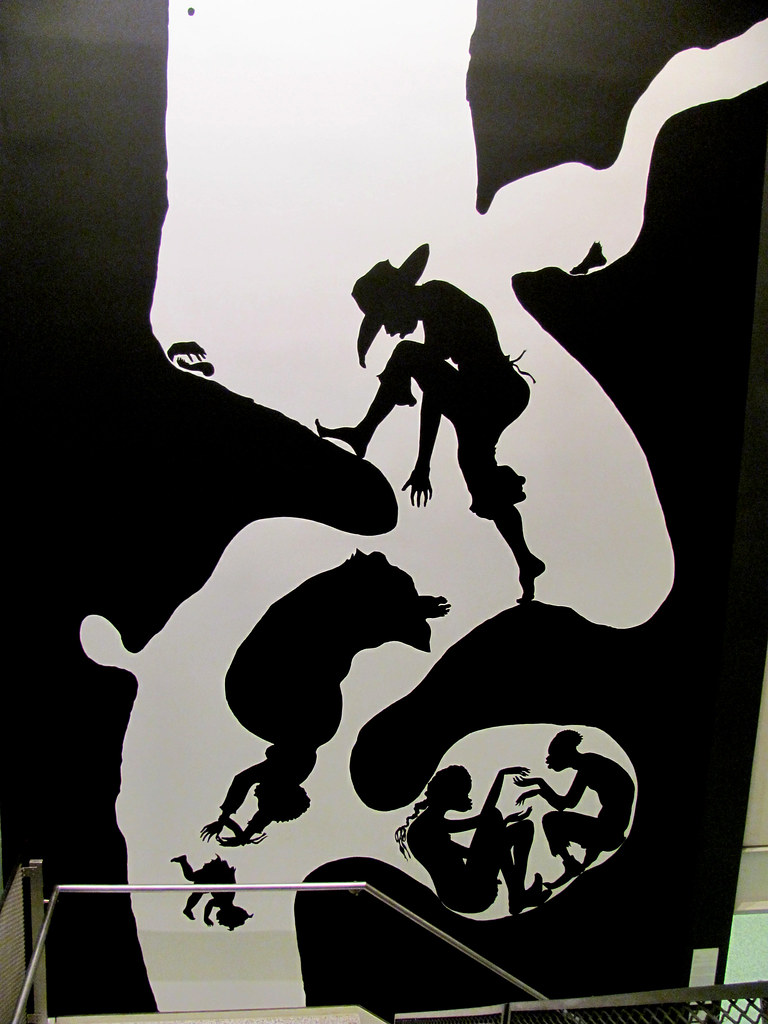
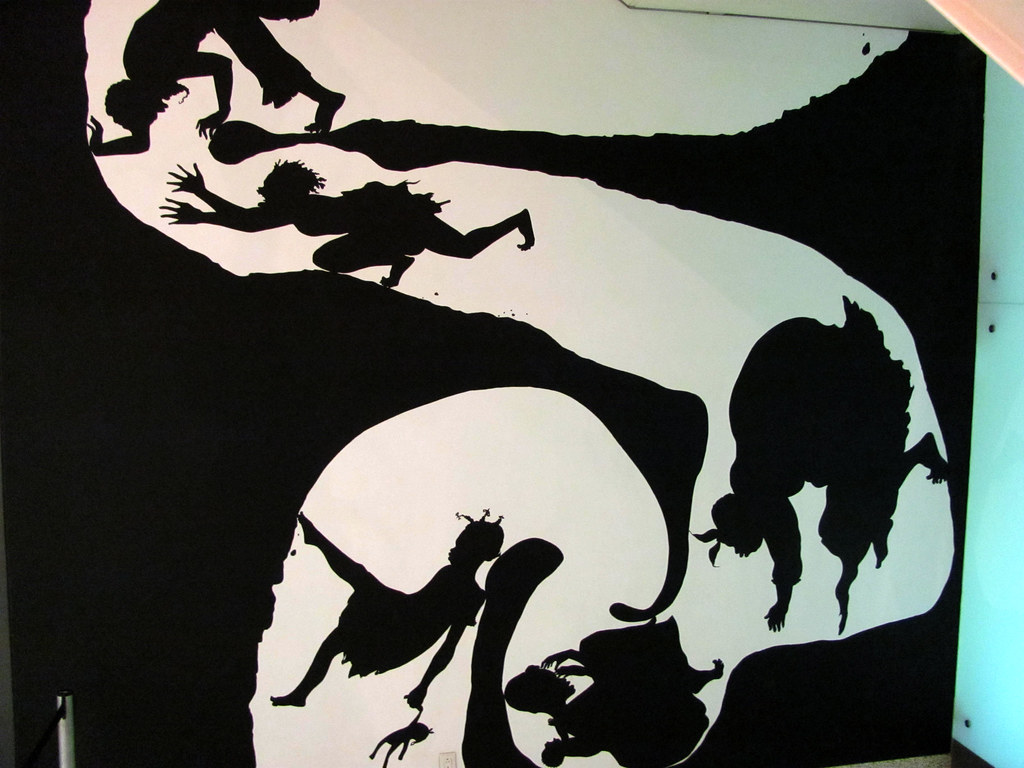
In 2014, the massive sugar factory in Brooklyn, New York, would be demolished. Walker designed a monumental sculpture to represent the exploitation of the people throughout the history of the sugar trade. The building was constructed in the late nineteenth century to store the raw sugar from the Caribbean before the sugar was refined and packaged; sugar was a luxury. Hundreds of thousands of slaves were taken to the Caribbean to work on the vast sugar plantations, building the sugar market on the backs of Africans shipped across the Atlantic. Sugar was also known as blood sugar, defining how humans bled through the exploited work in the fields or under the brutality of the overseers. Walker designed an immense sphinx-like woman, representing the building and the history of sugar. A Subtlety or the Marvelous Sugar Baby (8.2.35) is located between two rows of steel columns, the Sugar Baby appearing as a colossal goddess.
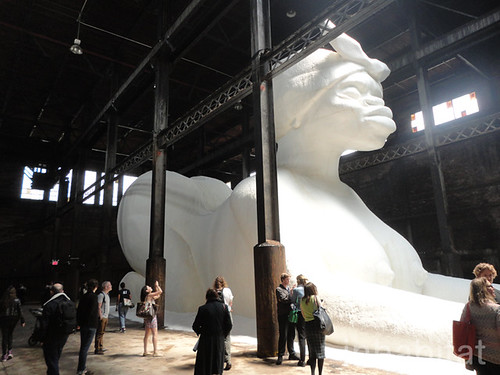
The sculpture was created from 330 huge polystyrene blocks and then covered with eighty tons of sugar—the sugar coating over the blocks allowing the seams of the polystyrene to show like quarried stone. When the Sugar Baby is approached from the front (8.2.36), her enlarged hands appear foreshortened, her pendulous breasts filling the space and her enigmatic face.

Walking around to the back of the statue (8.2.37), the viewer comes upon her buttocks jutting up from the shortened spine, thighs, and calves. "A powerful personification of the most beleaguered demographic in this country — the black woman — shows us where we all come from, innocent and unrefined."[11]
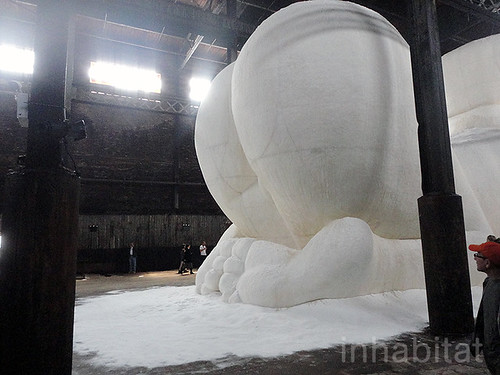
Around the Sugar Baby were thirteen small molasses-colored boys (8.2.38) standing about one and a half meters high. The statues were made from cast resin and covered in molasses or cast sugar, some light, others darker colors. The figures are carrying bananas or baskets, appearing to bring offerings, or they were only tired workers coming back from the cane fields. The whole installation remained in place for a little over two months. The building was open to the elements, and the weather eroded the sculptures before they were taken down.
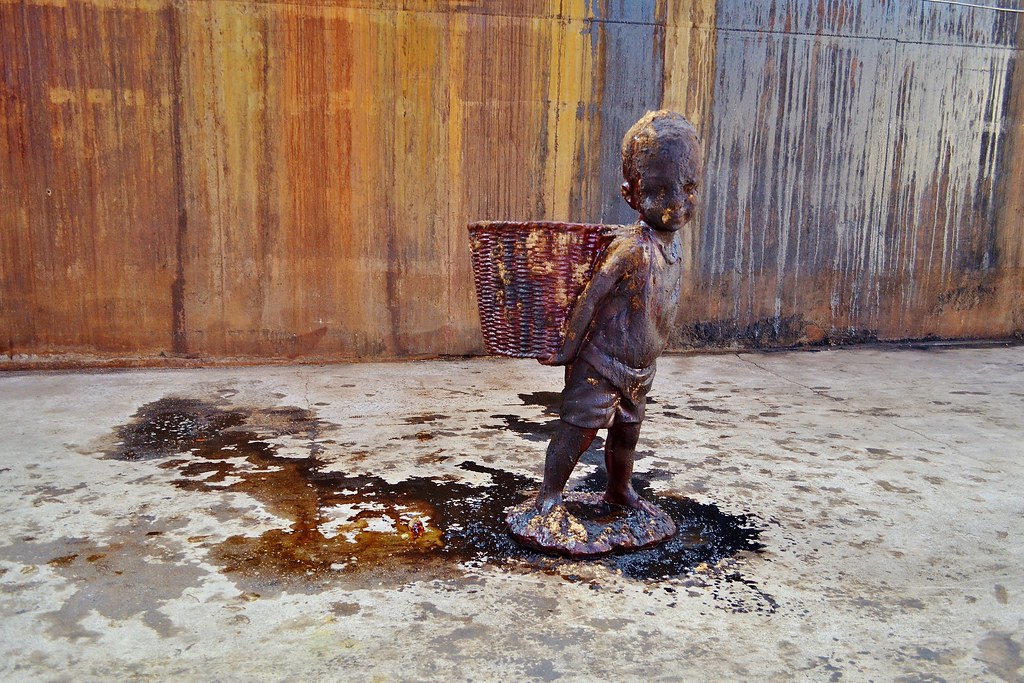
Liu Wei
Liu Wei (1972-) is from China and graduated from the China Academy of Art. At first, he created realistic paintings before working on installations. He moved to Beijing and was associated with other artists who produced exhibitions protesting the government. Their video, photography, and performances contained pictures of corpses, cadavers, or other gross and visceral images. Their concept planned on repelling Western audiences revealing their resentment of Western powers. However, as China expanded its trade globally, the artists opened to Western investors. Since the new millennium, Liu has been creating models of cityscapes using unusual materials. The massive construction of cities in China inspired him to create installations based on the continual change, decay, and construction found every day in cities. Today, Liu creates his image digitally before assembling an installation, continuing to change them over time.
Liu's installation Love it! Bite it! is made from the unusual material of dog chews. He tried to create buildings from across Western history. The work was exceptionally detailed, with ornate columns, domes, towers, and cornices. However, most of them resembled ruins of the dystopia of fallen empires. Liu made the construction from dog chews after seeing his dog gnaw on its chew as it was crumbled with saliva and dirt. He observed the dog's lust for food like a human's hunger for power, the city the representative of that power. Love it! Bite it! (8.2.39) displays the falling coliseum, a church, and other collapsing buildings.

Love it! Bite it! (8.2.40) is part of the United States capitol building exhibit eroded by greed and time.
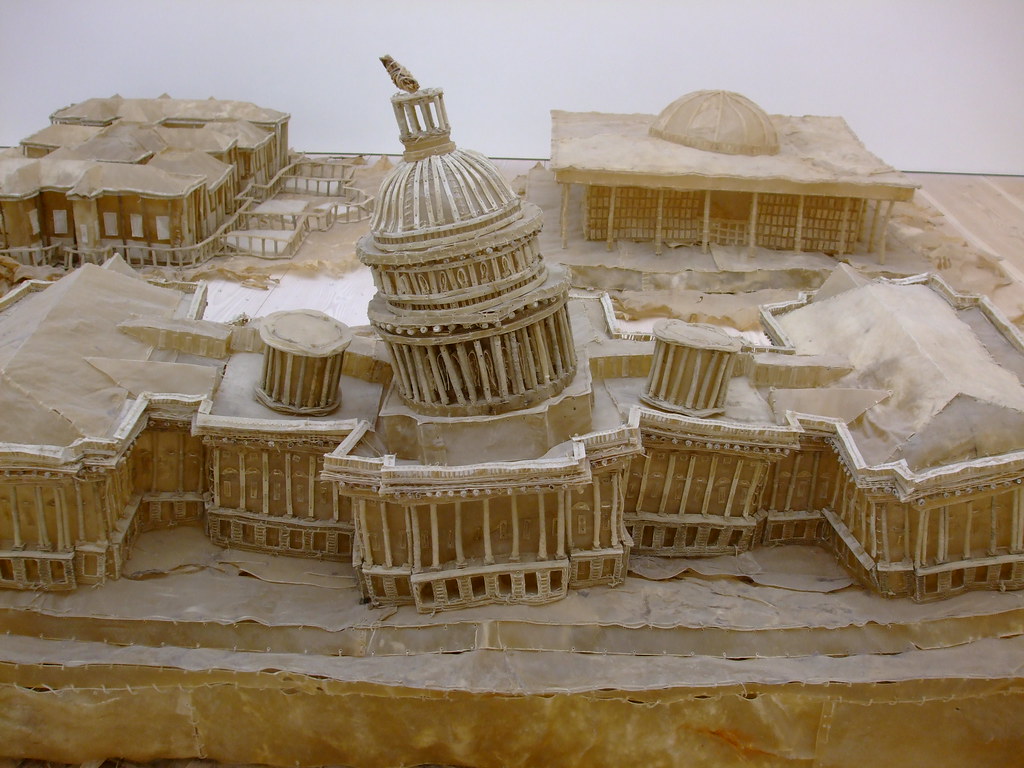
In Library II-II (8.2.41), Liu constructed four sections displaying another dystopian city with seemingly familiar buildings, although anonymous. Some of the buildings are leaning at ninety degrees; a few resemble old New York skyscrapers. All the buildings were made and sculpted with books. Liu said, "I was drawn to books at first because of the uniform density; the morphology of books seems to give them the ability to replace all other architectural and urban features; books represent a real-world and expand wantonly."[12] Liu used iron and hardware for the basic frame covered by wood to assemble the books into buildings.
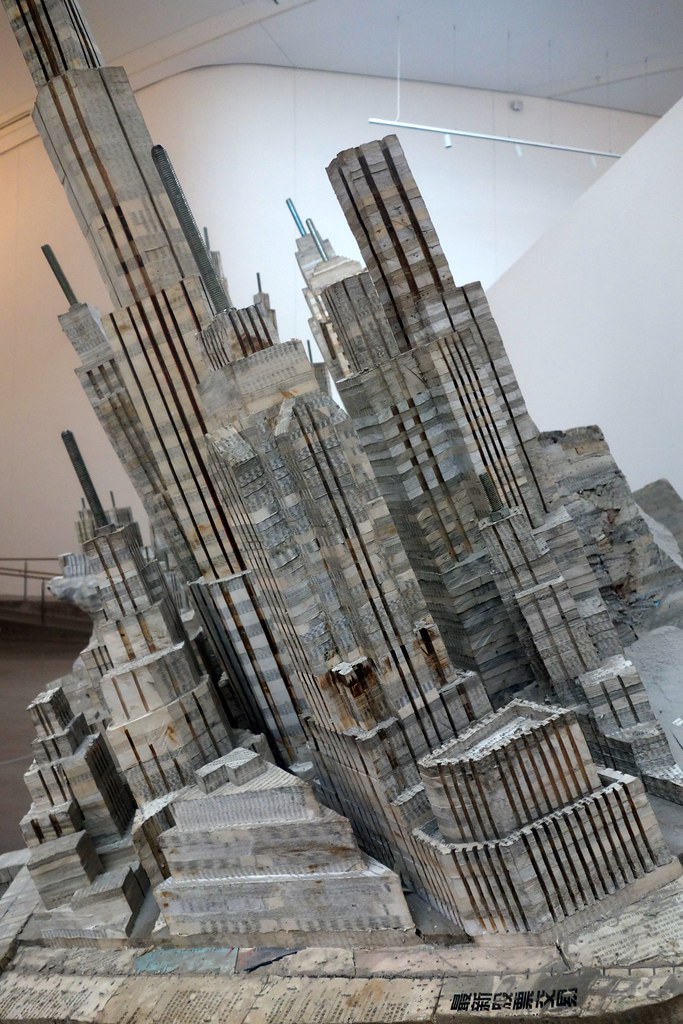
Urs Fischer
Urs Fischer (1973-) was born in Switzerland; his parents were doctors. At first, Fisher studied photography before opening his studio. Today, his work includes sculpture, drawing, painting, and his first interest in photography. Fisher's work is frequently classified as subversive and non-traditional, often creating oversized installations. Get Up Girl a Sun Is Running the World (8.2.42) is an installation based on 2,000-year-old olive trees found in the Italian countryside. He cast the trees in aluminum and covered them with white enamel. The natural trees' gnarled trunk and twisted branches are captured and frozen in time, then installed in an abnormal setting of concrete and glass, the beauty of the natural setting lost. Fischer said, "What interests me about the 2000-year-old olive trees is the fact that once they are cast bare naked, they become Memoriam of condensed time. Through a cast olive tree, you can not only experience the lapse of real-time, that is lived time, frozen in its given form but through this transformation also a different calibrated temporality."[13]
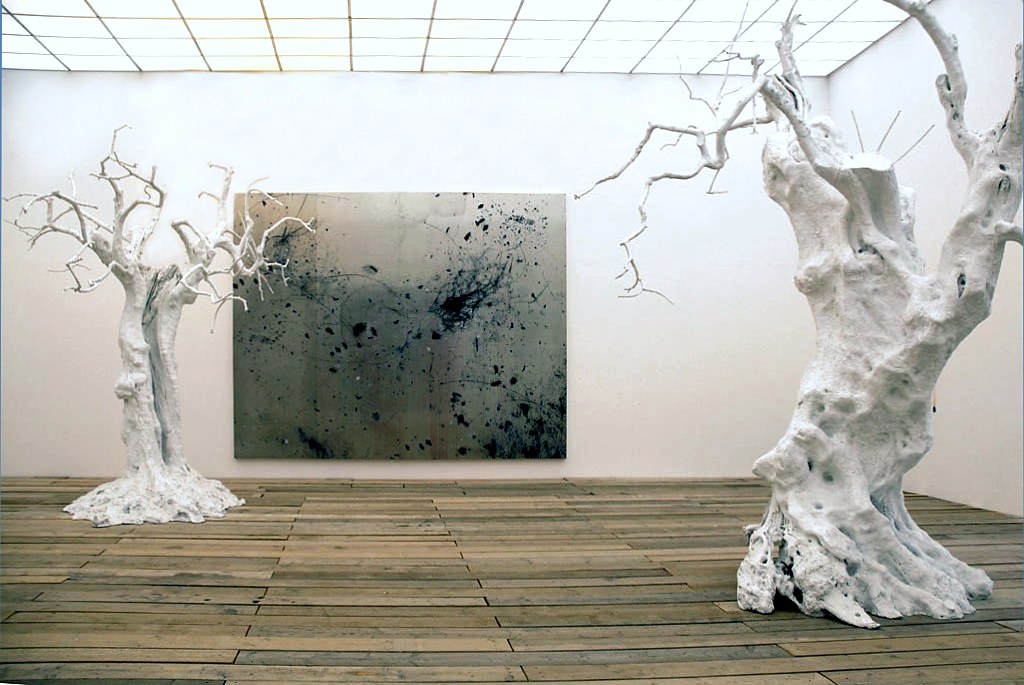
Fischer invited 1,500 people to help make clay structures for his exhibition of Yes (8.2.43, 8.2.44). The clay was provided for the people, and they were able to use all the clay needed and create anything they wanted. The people were from all walks of life, no experience required, and the results from the people were varied; some sculptures were polished, others were crude; they were large and small, made by young and old. The exhibit covered all of the floor space, and some people even used the walls. Objects included an array of unfired clay skulls, humble pretzels, Batman's head, octopi, dogs, birds, life-sized nudes, a bathtub, a fireplace, a tiny smartphone, a tombstone for chivalry (hah), a bowl of ramen, and an impressively giant and accurate Jabba the Hutt.[14]
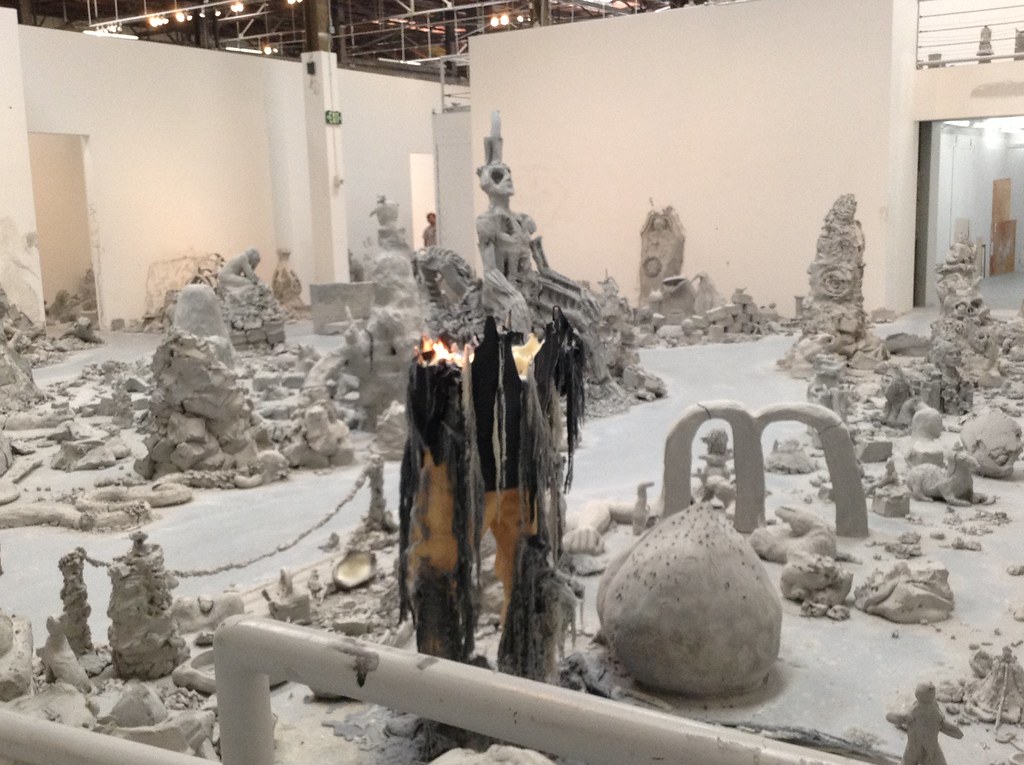
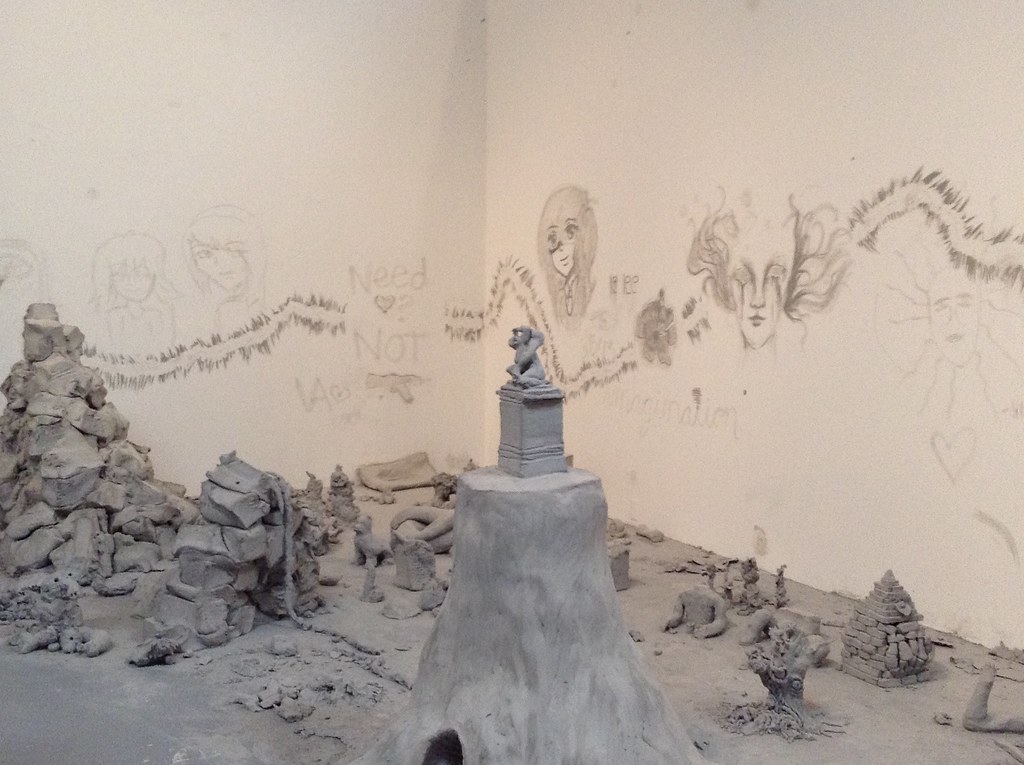
Fischer worked beside the people making his sculptures, including the immense wax sculpture Untitled (8.2.45), an image resembling Giambologna's Rape of the Sabine Women from the 1500s. Fischer placed wicks throughout the wax sculpture and then burned them to achieve the dripping and melted look of the statue. His oversized sculpture contrasted the smaller creations of the people, and the exhibition has the look of disparate pieces in a landscape of ruins, broken figures, and unassociated images.
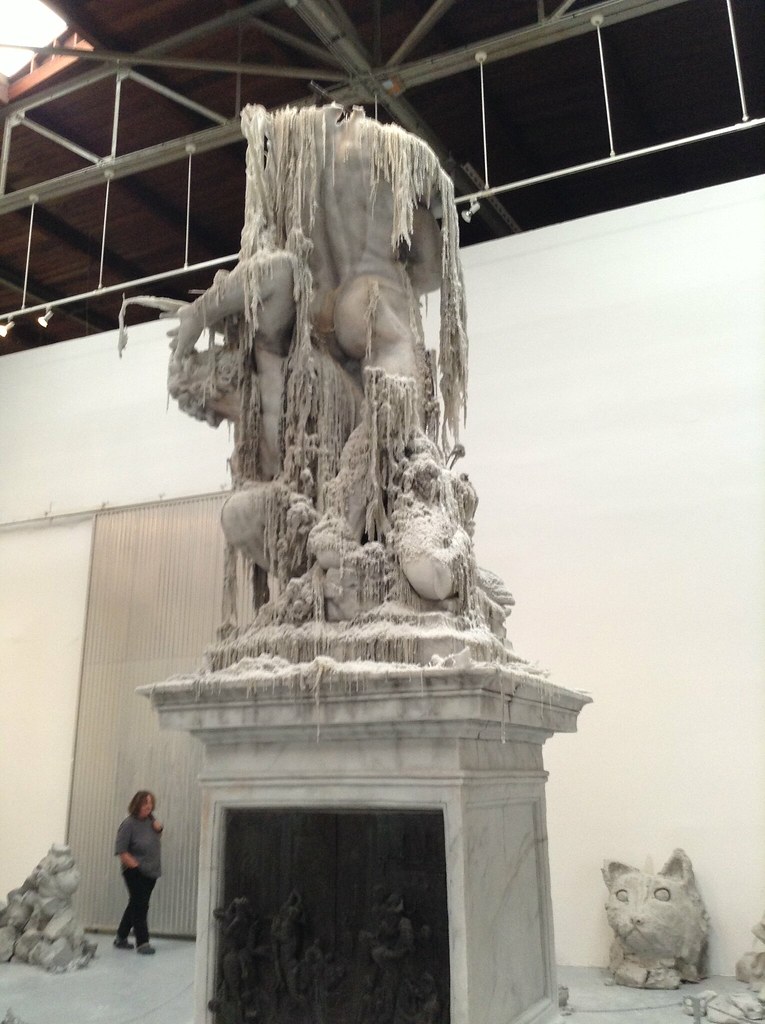
Fischer used the concept of ordinary objects to create the absurd. His monumental work, Untitled (Lamp/Bear) (8.2.46), is an image of a child's bright yellow teddy bear as part of a desk lamp. The mammoth bear is about two stories high as it sits, flopping forward. The bear appears to be sitting on the lamp as the light sits above his head, the giant lamp providing light for the outdoor space. The bear is wrinkled and looks cozy, ready to be held by a child. However, the bear is not made from soft fur as it appears; instead, it is cast of bronze and weighs about seventeen tons.
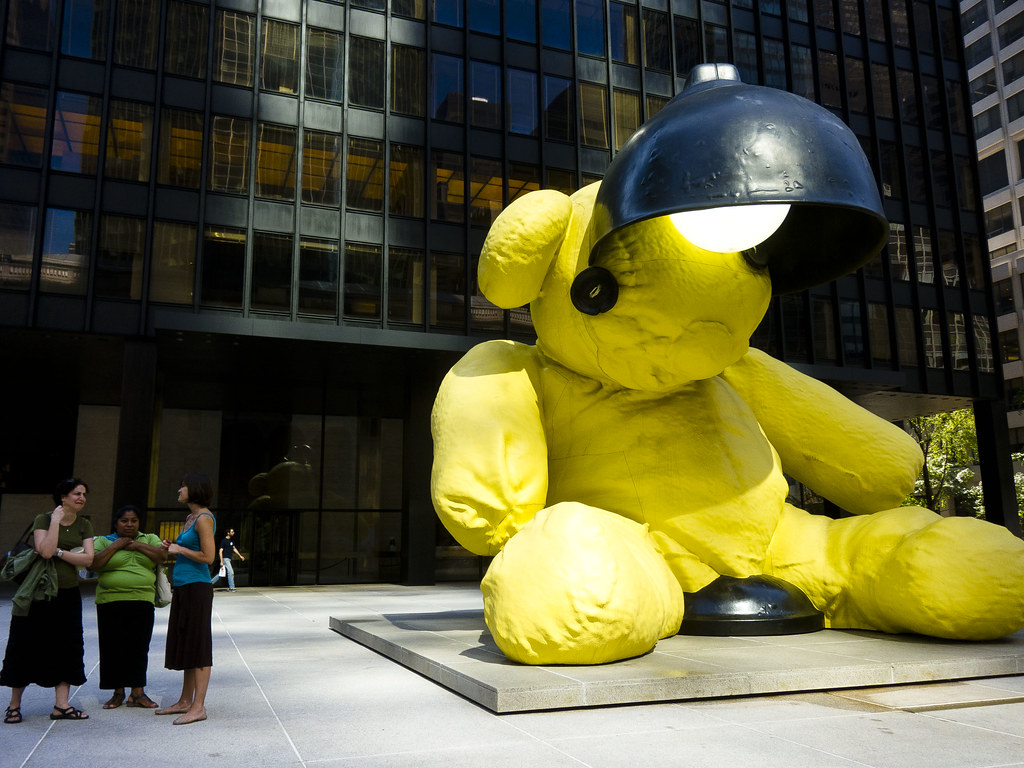
Olafur Eliasson
Olafur Eliasson (1967-) was born in Denmark, although his parents had recently emigrated from Iceland. His father was an artist and moved back to Iceland after divorcing Eliasson's mother. Eliasson studied art at the Royal Danish Academy of Fine Arts and then moved to Germany. His artwork is large and complex, so Eliasson collaborates with a team of architects and engineers, and other artists. He is also a professor at Berlin University, where he works with spatial experiments. Eliasson is well-known for creating multi-sensory exhibitions and combining scientific phenomena, environmental concerns, and art.
The weather has always been part of everyday conversation, will it be hot or cold or when the rain might start. Eliasson created The Weather Project (8.2.47) to bring the experience of the sun and sky. A fine mist is felt throughout the day as though coming from outside. At the end of the hall, hundreds of mono-frequency lamps, as installed in a semicircle, reflected in a huge mirror. The lamps contain a light restricted to a very narrow frequency, so they only emit yellow and black; any other colors become invisible. The result is a perfect sun seemingly static and unmoving, its light turning viewers into small black shadows. Eliasson has constructed the exhibition so viewers can also walk behind the sun and view how the electrical wiring, sub-structure, and misting machines are assembled and function. Aluminum frames were lined with the mirrored foil to create the reflective sun with the 200 lights in the semicircle.

The New York City Waterfalls (8.2.48) were a temporary installation during the summer of 2008 in New York City. The four waterfalls were situated on the East River at each bridge. The waterfalls were meant to enhance the public space and give people a sense of relationship with their surroundings. The basic structure was a set of scaffolding as the backbone for each separate fall, along with water pumps and hoses. The waterfalls were powered by electricity from "green power" and illuminated with LED lights. The fish were protected with special filters and intake pools to make the entire project environmentally sensitive. The cascading water brought a feeling of mountains and natural places in the middle of a congested urban area. The sound of falling water provides a softer sound among the harsh din of the city.
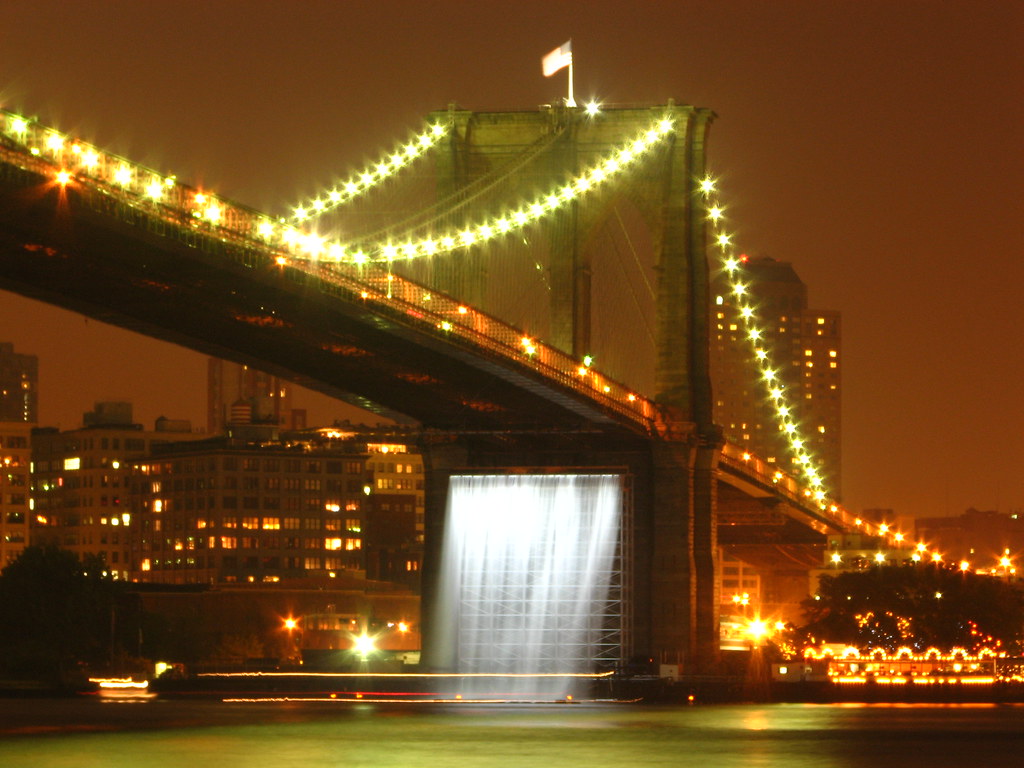
Eliasson wanted to bring the experience of the perspective of the horizon. He didn't think of the horizon as a line; instead, he felt it was a dimension. Eliasson explained, "Questioning one's horizon requires us to question linearity and create a new horizon."[15] His exhibit Inside the Horizon (8.2.49) is a series of forty-three triangular columns with varying widths running beside a grotto. Two sides of every column are covered with mirrors, and one side is clad in yellow glass tiles. The columns are illuminated from the inside. Each column is a different size and positioned at a different angle. Viewers walk through the columns, and their reflections create endless diffracted reflections on the water, building columns, and even themselves. The space becomes filled and changes with hundreds of facets and surprising visuals, much like a kaleidoscope.
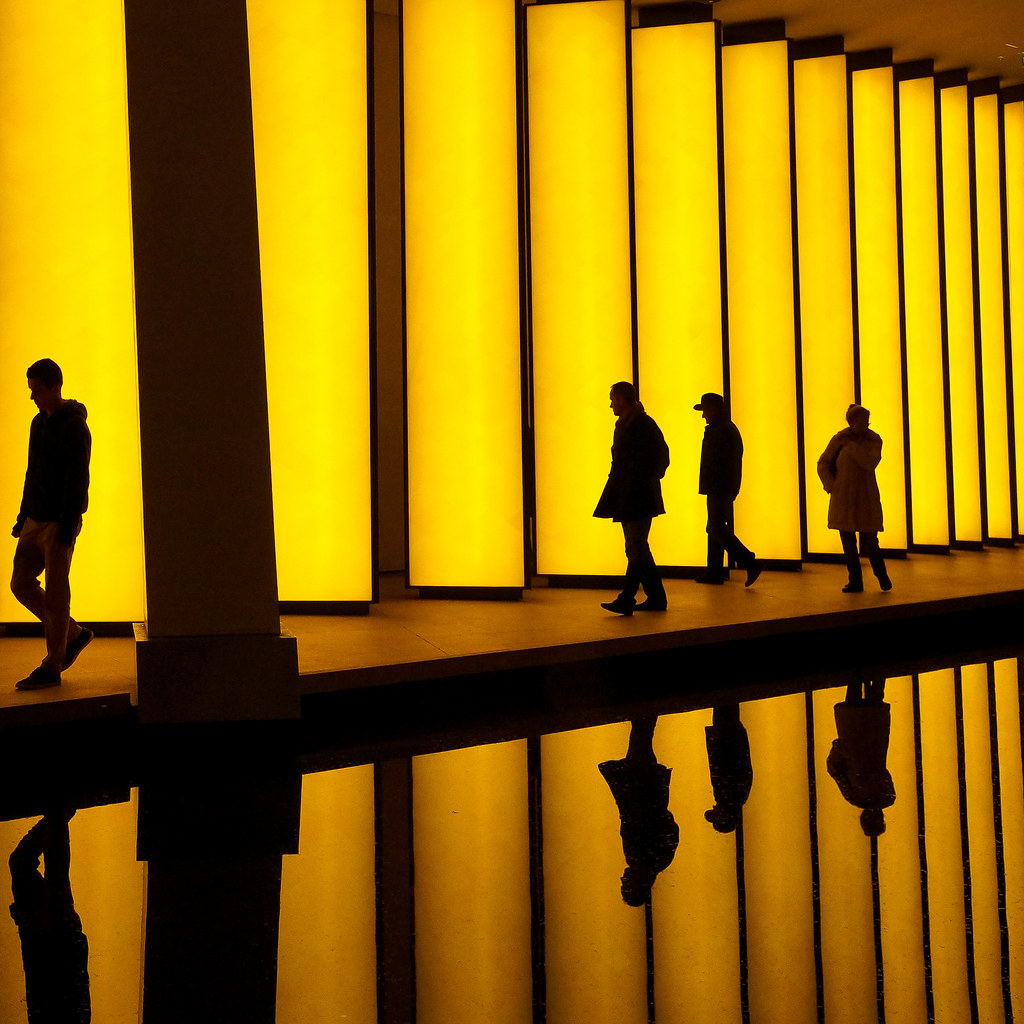
Bharti Kher
Bharti Kher (1969-) was born in England and received her BA from Newcastle Polytechnic. She moved to India in 1993, where she still lives. Her art is based on a relationship of an object and its metaphysical and material dimensions and how she repositions the concepts and thoughts the viewer previously held. Most of her work includes the bindi, the red dot women in India apply to their forehead between the eyebrows. The red dot contains significant traditional and religious meanings and is generally associated with the Hindu definition of the third eye. Kher explained, "Many people believe it's a traditional symbol of marriage while others, in the West particularly, see it as a fashion accessory… But actually the bindi is meant to represent a third eye – one that forges a link between the real and the spiritual-conceptual worlds."[16] Kher uses the bindi as part of her art, shifting the meaning. Her sculptures are generally fantastical, blurring the lines between real and mythical, typically made from found objects with their own definition, which becomes changed. Kher makes her objects open to misinterpretation, magical thinking of abstract forms.
The Skin Speaks, a language not its own (8.2.50), is Kher's most well-known work. She became interested in the concept of elephants after seeing a photograph of a collapsed elephant being put into a truck, an image she remembered for a long time before making her elephant. The life-sized elephant is made from fiberglass and lies on the ground on its stomach with its head turned. If an elephant dies, it falls to the ground on its side, and this elephant is sited differently. The elephant is covered with white bindis forming unending patterns on the elephant. Kher used the bindi to act as a skin on the elephant giving life to something dying. The heavy elephant appears to be lifted by the thousands of bindis as the bindi do not stop while they move over the elephant's skin. The elephant's head is turned, and the eye appears to look at the viewer.
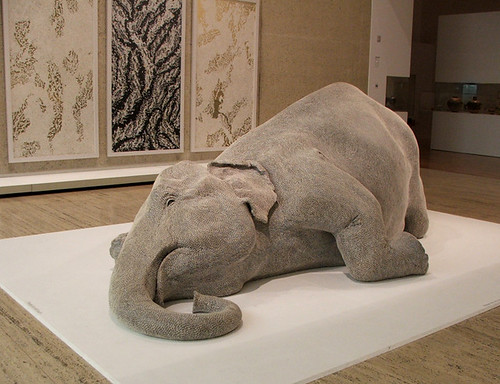
Kher wanted to create the heart of the massive blue sperm whale; however, she did not find enough scientific documentation about the construction of the whale's heart, so she invented her version in An Absence of Assignable Cause (8.2.51). Kher designed the life-sized heart and added veins and arteries jutting out from the enormous heart. The entire sculpture is covered with colored bindis, which Kher applies individually to create precise patterns and create movement. The monumental installation also reflects the position of the immense whale in the disintegrating environment.

Installation art is based on multiple earlier movements, including the reuse and small installations of Dada or Performance Art creatively using and interpreting space, even conceptual art and the focus on the ideas over the aesthetic.
[1] Retrieved from https://www.tate.org.uk/whats-on/tat...unflower-seeds
[2] Retrieved from https://www.magasin3.com/en/artwork/world-map-2/
[3] Retrieved from https://www.gap.net.au/yayoi-kusama
[4] Retrieved from https://mattress.org/works/infinity-...mirrored-room/
[5] Retrieved from https://www.tate.org.uk/art/artists/...-is-el-anatsui
[6] Retrieved from https://www.artnews.com/art-news/art...ungry-god-172/
[7] Retrieved from https://www.indiatoday.in/magazine/society-the-arts/story/20140127-subodh-gupta-and-his-creation-delhi-799864-1999-11-30
[8] Retrieved from https://www.npr.org/templates/story/...ryId=103674782
[9] Retrieved from https://stljewishlight.org/arts-ente...s-masterpiece/
[10] Retrieved from https://www.royalacademy.org.uk/arti...eginners-guide
[11] Retrieved by https://www.nytimes.com/2014/05/12/a...ino-plant.html
[12] Retrieved from http://whatsupmiami.blogspot.com/201...at-basels.html
[13] Retrieved from https://www.phillips.com/detail/ugo-...one/UK010411/4
[14] Retrieved from https://hyperallergic.com/69868/urs-...he-overcooked/
[15] Retrieved from https://www.fondationlouisvuitton.fr...de-the-horizon
[16] Retrieved from https://www.hauserwirth.com/artists/2793-bharti-kher/


